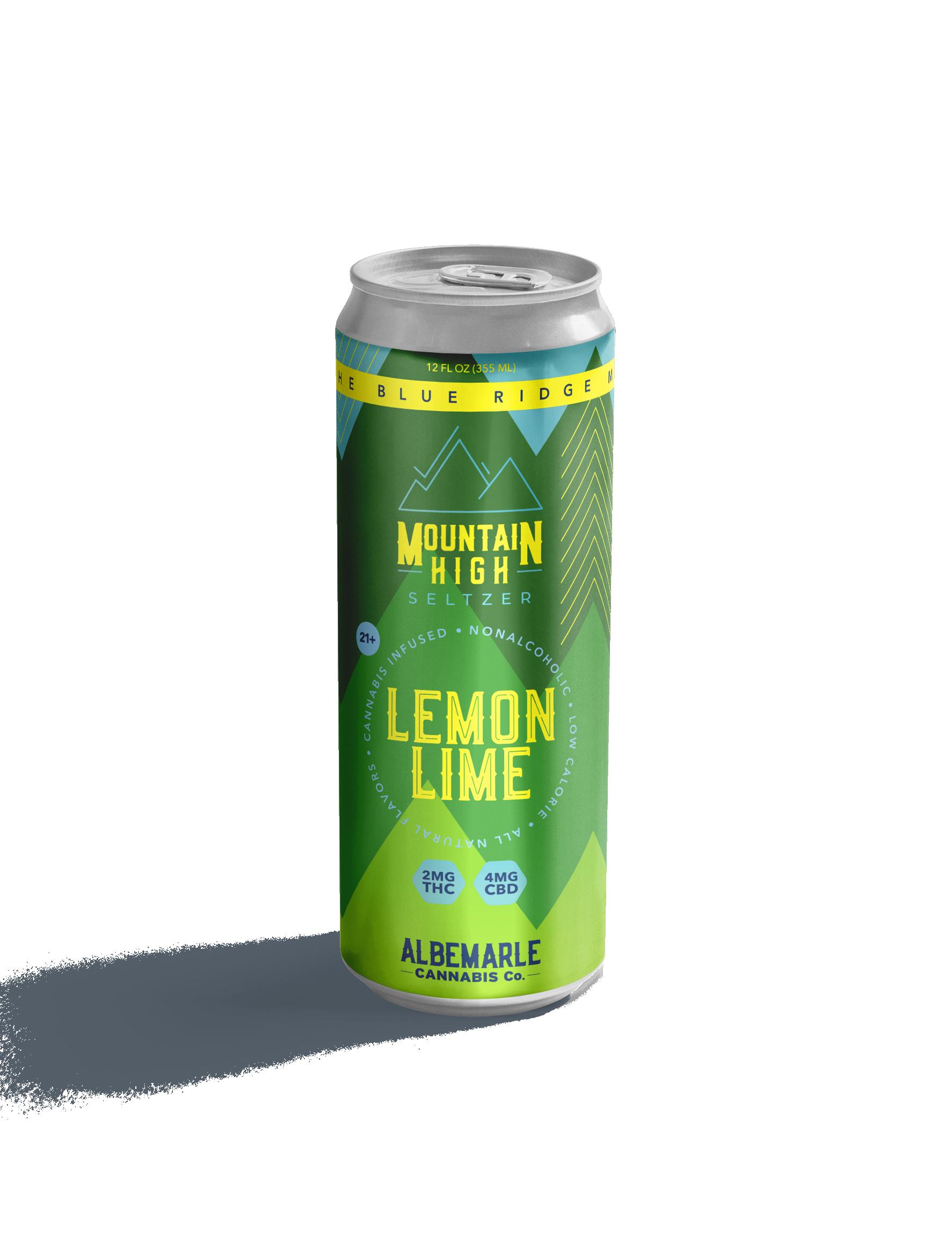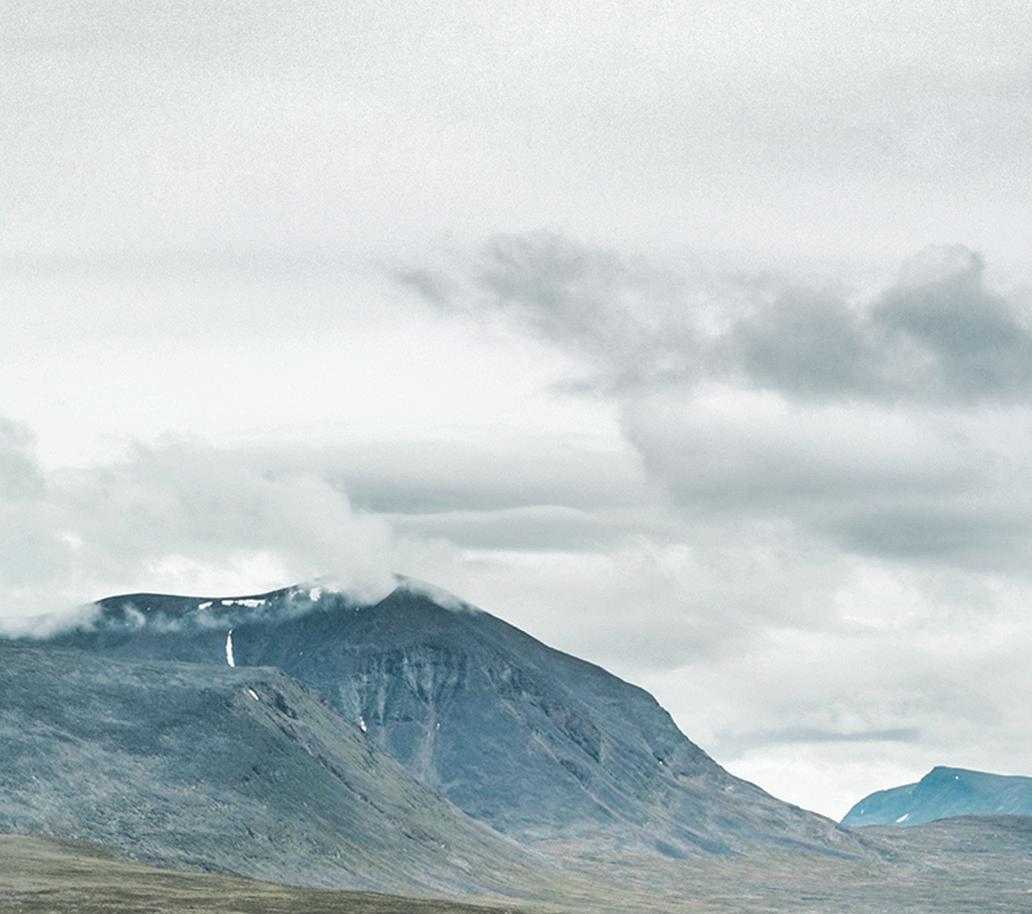




etsu.edu/gobeyond






etsu.edu/gobeyond
We are the Southern Environmental Law Center, one of the nation’s most powerful defenders of the environment, rooted right here in the South. As lawyers, policy and issue experts, and community advocates and partners, we take on the toughest challenges to protect our air, water, land, wildlife and the people who live here. Together, we can solve the most complex environmental challenges right here in the South.

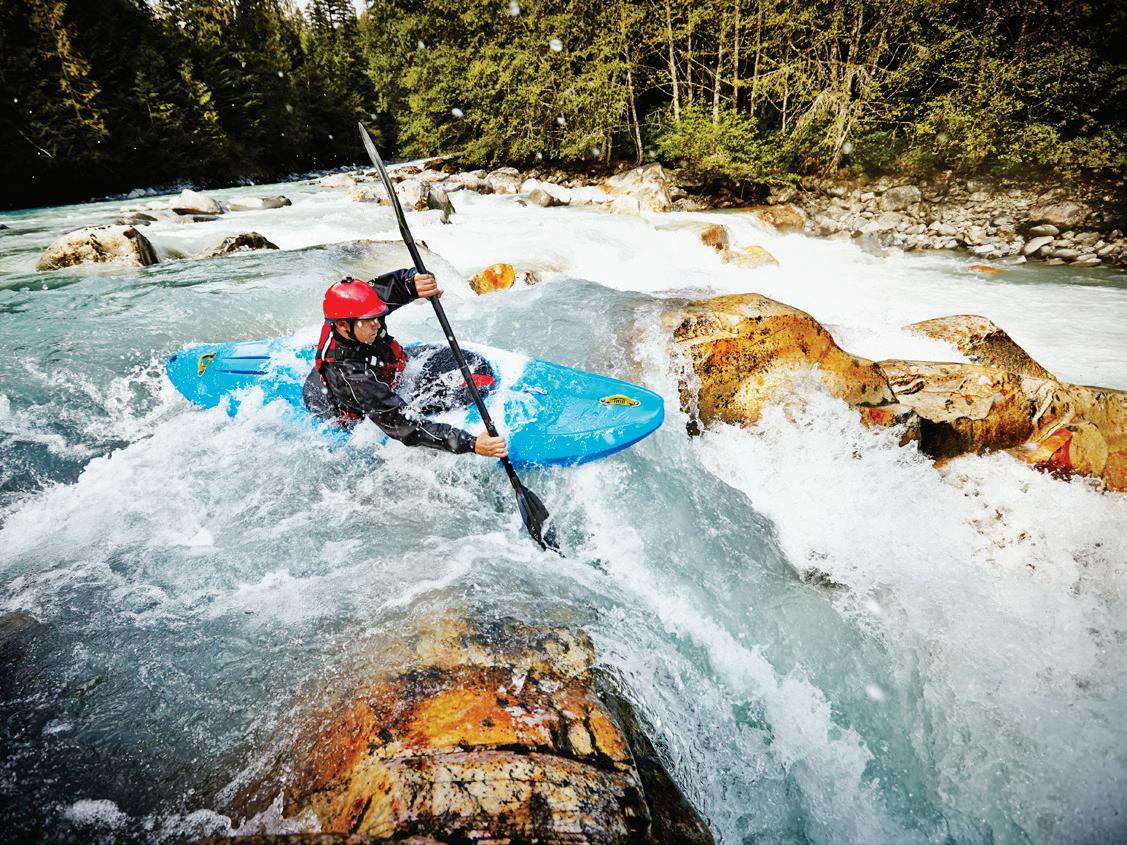

PRESIDENT BLAKE DEMASO blake@blueridgeoutdoors.com
EDITOR IN CHIEF JEDD FERRIS jedd@blueridgeoutdoors.com
PUBLISHER LEAH WOODY leah@blueridgeoutdoors.com
ASSOCIATE PUBLISHER KATIE HARTWELL katie@blueridgeoutdoors.com
CREATIVE DIRECTOR MELISSA KENNELLY m.kennelly@blueridgeoutdoors.com
EDITORIAL & PRODUCTION
SENIOR EDITOR WILL HARLAN will@blueridgeoutdoors.com
GEAR EDITOR DOUG SCHNITZSPAHN doug@elevationoutdoors.com
DESIGNER/ART MANAGER REBECCA CENCEWIZKI art@blueridgeoutdoors.com
CONTRIBUTORS
DAVE STALLARD
GRAHAM AVERILL
ERIC J. WALLACE
An interview with Virginia Senator Tim Kaine, who just wrote the new book, Walk, Ride, Paddle: A Life Outside.
Why it’s important to buck the routine and embrace the strange.
LAUREN STEPP MARY BETH SKYLIS MIKE BEZEMEK
COPY EDITORS
JULIA GREEN, ROBERT MCGEE
ADVERTISING & BUSINESS
ACCOUNT EXECUTIVE BUCK BRICE buck@blueridgeoutdoors.com
ACCOUNT EXECUTIVE HANNAH COOPER hannah@blueridgeoutdoors.com
ADVERTISING CONTENT COORDINATOR AMANDA LIVERETTE amanda@blueridgeoutdoors.com
BUSINESS MANAGER MELISSA GESSLER melissa@blueridgeoutdoors.com
DIGITAL MEDIA
ONLINE DIRECTOR CRAIG SNODGRASS webdir@blueridgeoutdoors.com
CREATIVE CONTENT MANAGER SHANNON MCGOWAN shannon@blueridgeoutdoors.com
CIRCULATION INQUIRIES circulation@blueridgeoutdoors.com
ADVERTISING INQUIRIES advertise@blueridgeoutdoors.com
SUMMIT PUBLISHING
977 SEMINOLE TR PMB294
CHARLOTTESVILLE, VIRGINIA 22901
ASHEVILLE, NORTH CAROLINA
BLUERIDGEOUTDOORS.COM
©2024 Summit Publishing, LLC. ALL RIGHTS RESERVED
GOT A STORY IDEA OR COMMENT? submit@blueridgeoutdoors.com BLUERIDGEOUTDOORS.COM
Keep your stride right with this new running gear.
50
Fresh tunes from Widespread Panic, Steep Canyon Rangers, and Steve Earle.


8 | ATHLETE ADVICE
Peak performers in paddling, biking, and running share training tips.
Southern cities are developing small patches of greenspace to help get residents outside.
Explore the outdoor opportunities at East Tennessee State University, this year’s winner of BRO ’s Top Adventure College contest.
An explorer finds treasure at a forgotten national recreation area on the Tennessee-Kentucky State Line.
These endurance races will test your mettle and take you deep into the mountains.
When a dad has had enough of his kids’ excessive screen time, he signs the family up for a multi-sport adventure.
When her husband became permanently disabled, a woman found accessible spots for them to explore the outdoors.



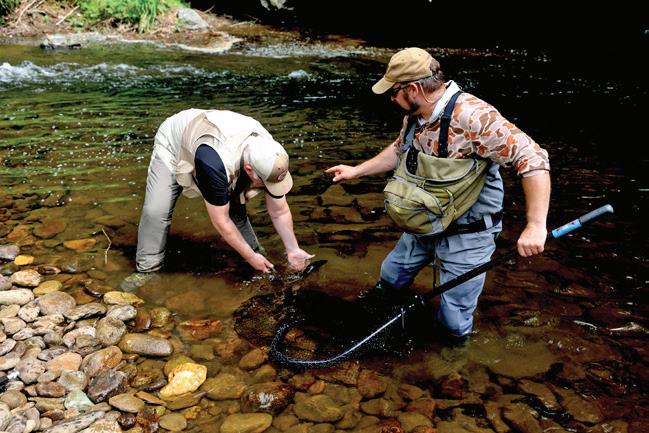



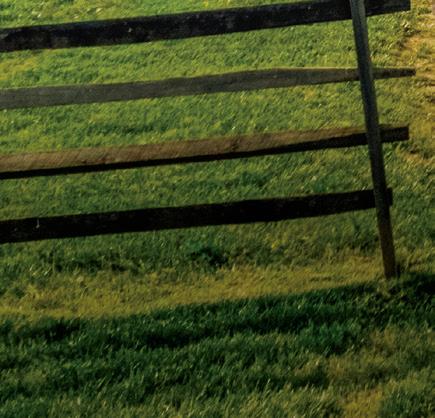







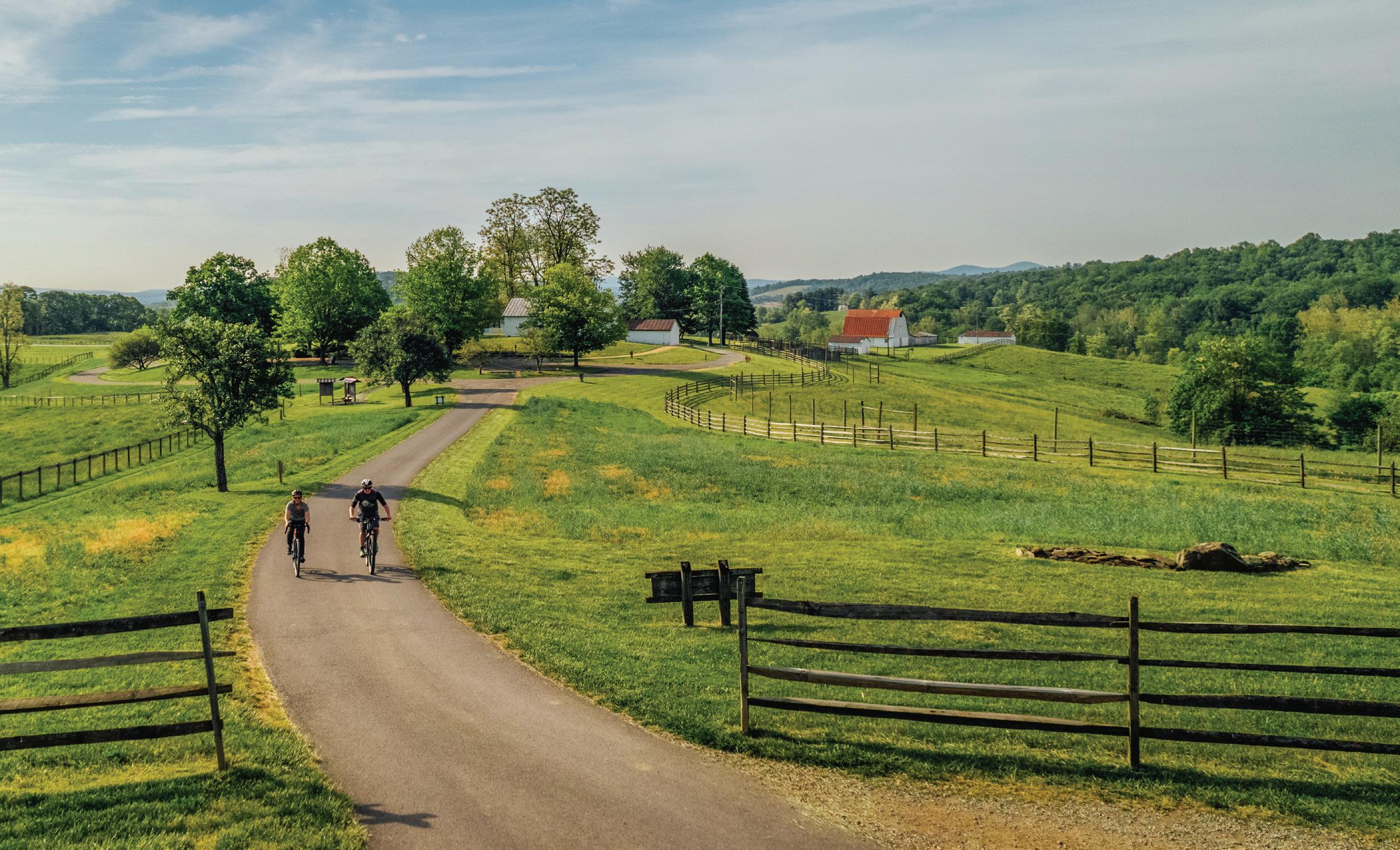
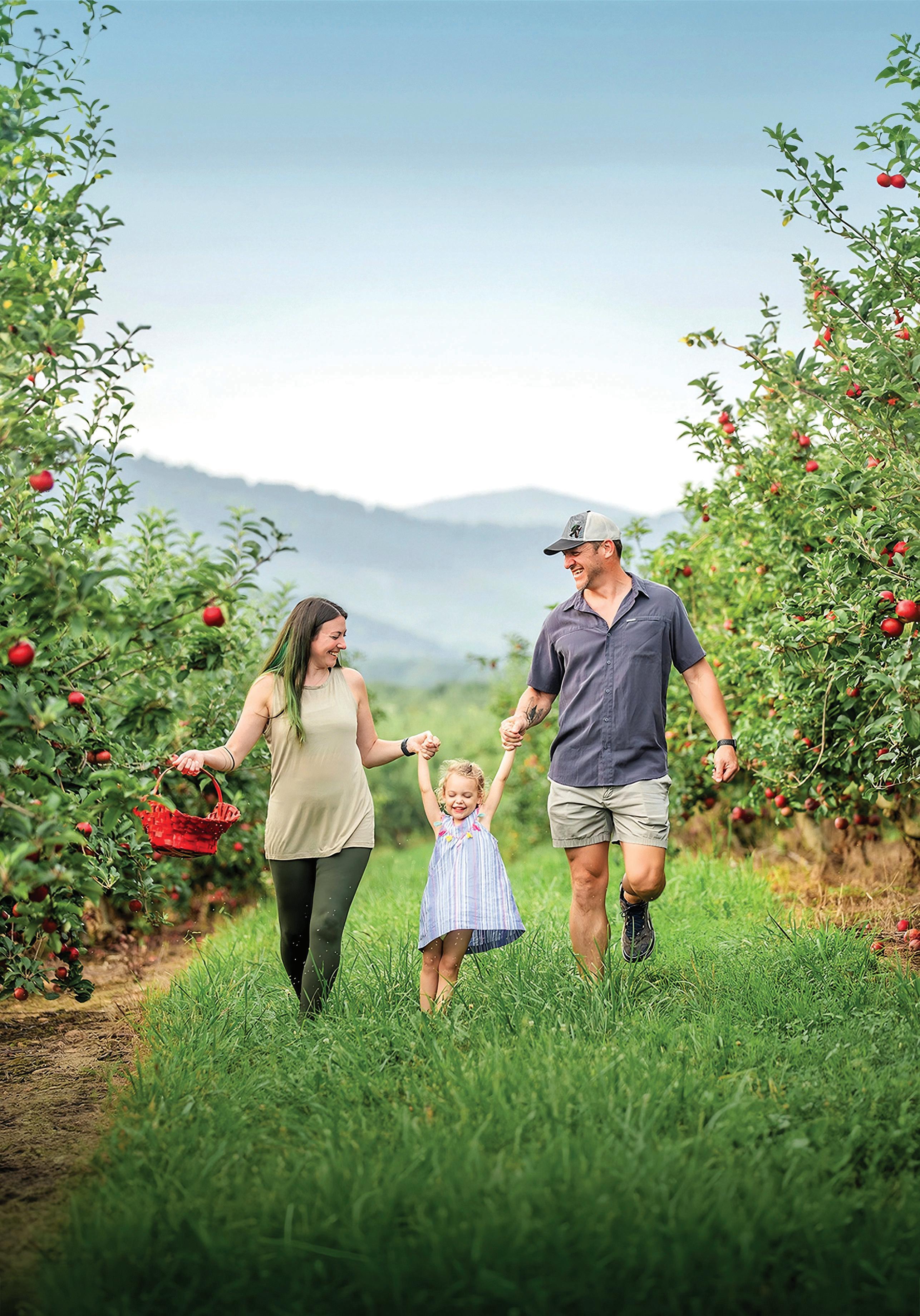
BY ERIC J. WALLACE
IN 2018 SENATOR TIM KAINE WAS approaching a pair of personal and professional milestones: His 60th birthday and 25th year of service as an elected public official. The latter had been a remarkable ladderclimb from city council, to mayor of Richmond, governor of Virginia, two-term senator, and 2016 running mate to democratic presidential candidate Hillary Clinton.
Kaine knew he wanted to do something big to celebrate. But what should it be? A conversation with in-laws about a designated outdoor adventure experience in New York and his lifelong love for nature sparked an idea: Create an epic triathlon that highlighted Virginia’s most treasured natural assets. Kaine spent the next three years hiking the Commonwealth’s 559 miles of Appalachian Trail, cycling 321 miles along the Blue Ridge Parkway and Skyline Drive, and paddling 348 miles on the James River.
BRO spoke with Senator Kaine about his experiences, which he wrote about in a new book, Walk, Ride, Paddle: A Life Outside.
BRO: Any one of these treks would test the mettle of an experienced adventurer. Fill us in on your background with outdoor recreation?
TK: My love for the outdoors, and camping in particular, began in the Boy Scouts while growing up in Kansas City. By all measures I was a lackluster Scout. But we’d go on these annual camping trips and I’d always get really excited and active in the troop leading up to those. I remember that the first was a winter trip, of all things, and for whatever reason I just fell in love with the experience. I was hooked
immediately.
Then I was lucky enough to have a seventh-grade shop teacher who really liked to camp and would sometimes ask if anyone wanted to come along. He and another teacher would load up their cars on Friday and take a group of four to 20 boys out for the weekend. It was amazing! I came back from those trips and convinced my parents to give it a try. And they wound up getting really into it, too.
In college I tried caving, canoeing, cycling, hiking—and loved all of it. I met my wife, Anne, in law school and she was as avid about the outdoors as I was. In fact, it was [largely Virginia’s abundant canoeing, hiking and camping opportunities] that convinced us to settle in Richmond. Our honeymoon was a backpacking trip in the Pyrenees, and we had our kids in tents and on rivers early on. Getting outside into nature has and continues to be a huge part of our life together.
BRO: Tell us about the inspiration behind taking on such a major adventure?
TK: We were visiting my brother and sister-in-law shortly after I’d been reelected to the senate in 2018, and they were talking about completing the [Adirondack] 46er in New York. [That’s an outdoors challenge where] you hike every peak in the state that’s over 4,000 feet. It’s well-known up there. I thought, ‘When it comes to nature, it doesn’t get better than Virginia. What if I could use this opportunity to [celebrate my personal milestones] and create a similar nature quest here?’ From there it was asking, ‘What are the nature experiences that best capture the essence of our
state?’ The Blue Ridge Parkway, Appalachian Trail, and James River came to mind immediately — an epic Virginia Adventure Triathlon.
At that point, I knew that was going to be the quest. [The goal was to] write a book that would use my personal experience to shine a light on those incredible assets and hopefully establish something new in the process.
BRO: Orchestrating all this must have been tough. How did you fit the trips into your busy schedule?
TK: The senate schedule is designed to have 36 weeks in office with the other weeks of recess for state travel. In a typical year you get out, do events all across the state, talk to people, [meet with organizations, city officials, groups,] and so on. What I decided was to use at least a portion of my three recesses from 2019 to 2021 to do the same thing, but in a very different way. I’d travel the state, but it wouldn’t be by car. I’d meet and talk to people, but it would just be whomever I happened to bump into along the way.
[Meanwhile,] I had experience with what I was doing, so I wasn’t going in blind. I’ve done quite a few canoe-camping trips and own a 40-year-old, Old Town camper canoe. I’d cycled the Parkway with a group of friends 25 years back. And I’d hiked probably 80-100 miles of Virginia A.T.
That said, the logistics of
canoeing the final 100 miles of the James River from Richmond to the Chesapeake Bay were tricky. I had never done any [serious, longdistance paddling in that region]. I had to learn tidal charts, figure out how many miles I could realistically complete in a day, what to do about shuttles, where to stay. That was definitely the toughest element.
BRO: Have these adventures changed your approach to legislation around outdoor recreation and public lands protections?
TK: Definitely. I’ve always been passionate about these things, but this experience inspired me to go further with my advocacy and really prioritize them. For instance, we have the centennial of the Appalachian Trail coming up and I’m working with the Appalachian Trail Conservancy on a national centennial bill. I’m also leading an effort to make the Great Dismal Swamp a designated national heritage area. And, more generally, I’m pushing for funding increases in parks.
I feel these issues are of particular importance right now. While on my quest I realized that, while we are obviously in a time of tremendous political polarization, with nature, we aren’t polarized around everything. It was comforting that, regardless of their political beliefs, everyone I encountered shared a common love for preserving natural beauty.



Training, eating, and gear tips from some of the region’s most impressive athletes
BY LAUREN STEPP
FOR MANY, RUNNING 30 miles through the mountains is unthinkable. But to many competitive athletes, that’s just an average Tuesday. Intent on learning more about what makes these superhumans tick, BRO chatted with four forces: a runner, a long-distance hiker, a mountain biker, and a paddler. Here’s how they go the distance.
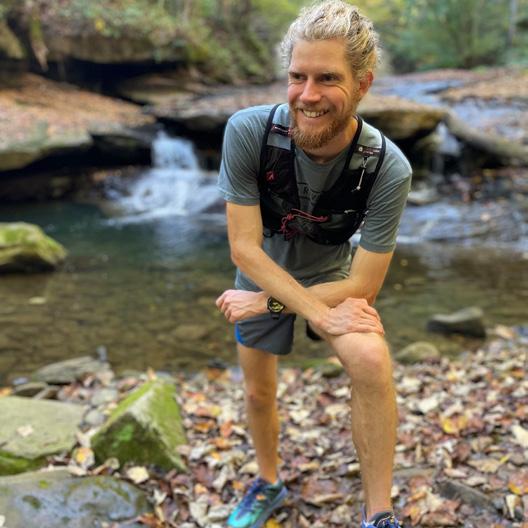
Huntington, West Virginia
Like many kids, Caleb Bowen wanted to grow up to be just like his dad. That’s why he started logging miles in elementary school.
“My dad had started running to get in shape,” says Bowen. “I thought it was the coolest thing watching him fall in love with running.”
Hoping to keep pace, Bowen laced up. He’s been running ever since, taking second place at the Grindstone 100K in 2023 (which earned him a golden ticket to the Western States Endurance Run) and winning the 2020 and 2021 Rim to River 100. Bowen also coaches cross country and track and field at Marshall University in Huntington, W.Va.
How I Train: Most weeks, I run doubles about four days a week with a long run of 18 to 25 miles on Sundays.
What I Eat: My go-to meals on an average day are avocado toast with five eggs, bacon, and two hash browns with syrup; the classic peanut butter-and-jelly or turkeyand-cheese sandwich; frozen pizzas; and 90-second rice with chicken, porkchop, or steak with peas.
Piece of Gear I Can’t Live Without: I think my favorite piece of gear is my Coros Pace 3 GPS watch. I depend on this watch for everything, and I love how long the battery lasts.
My Peak Race Moment: The moment I knew I was going to finish in the top two at Grindstone this past September and get a golden ticket to Western States was such an amazing moment in my life. Getting a golden ticket was my dream and, to be honest, I wasn't sure if it was even possible.



In 2008, the North Carolina native set the record for the fastest Appalachian Trail hike by a woman in 57 days, eight hours, and 13 minutes. Three years later, she returned to the famous footpath and polished it off in 46 days, 11 hours, and 20 minutes. A year after that, she was named a National Geographic Adventurer of the Year. Now, Davis is less focused on breaking records and more focused on changing public policy surrounding outdoor recreation. But she’s still known to log a mile (or 200).
What I Eat: My diet is gratitude—I am grateful for whatever is in front of me. THANKS TO RIGOROUS TRAINING, CALEB BOWEN
Jennifer Pharr Davis isn’t a competitive athlete in the traditional sense. Unlike others listed here, she doesn’t strive for medals or a spot on the podium. However, Davis does push the limits of what is humanly possible.
How I Train: I chase my kids around. Or ride my secondhand peloton. On top of that, I hike and get on-trail whenever I can.
Piece of Gear I Can’t Live Without: My Sawyer Micro water filter.
My Peak Race Moment: When I was thru-hiking the A.T. in 2005, I was up at Jane Bald near Roan Mountain at sunset. I felt like I had this epiphany that I wasn't just an observer of nature but a part of it. That was transformative for me, and I think shaped the rest of my life.

Grind Gravel and Coffee with Biker Jeremiah Bishop
Harrisonburg, Virginia
As an at-risk kid growing up outside of Baltimore, Jeremiah Bishop had a choice: Get into serious, juvenile detention-worthy trouble or get into some “two-wheeled trouble” instead. He chose the latter.
Today, Bishop stands as America’s leading mountain bike stage racer, having won competitions like the Breck Epic and Pisgah Stage Race. In 2003, he also won the gold medal in the cross-country mountain bike event at the XIV Pan American Games in the Dominican Republic.
“I am so lucky I found a sport that gave me the wings I needed to see the world and find a focus,” says Bishop, who is now based out of Harrisonburg, Va.
How I Train: My rides are usually about one-third mountain biking, one-third gravel cycling, and one-third road cycling. I log anywhere between eight to 30 hours a week.
What I Eat: I always try to get in some vegetables, plus added protein for recovery. But coffee and good homemade chocolate chip cookies with pecans are my vices.
Piece of Gear I Can’t Live Without: Bikes, of course. I have five different Canyon bikes. Each bike has a


• LODGING FOR THREE NIGHTS IN A JUNIOR SUITE FOR 4 (2 ADULTS AND UP TO 2 CHILDREN)
• DAILY BREAKFAST
• CHOICE OF ONE OUTDOOR ADVENTURE CENTER ACTIVITY (HORSEBACK RIDING, CLAY SHOOTING OR RTV)

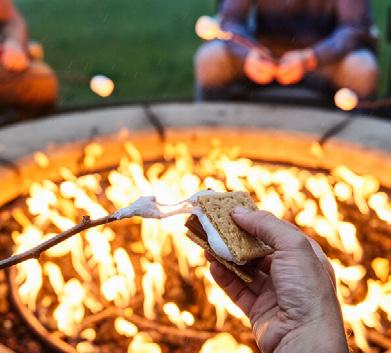


• PLUS A STARGAZING EXPERIENCE!
Terms and Conditions: For use Mar 1 - June 15, 2025. Room category of Junior Suite or above. Based upon availability, blackout dates include May 23-26, 2025.




















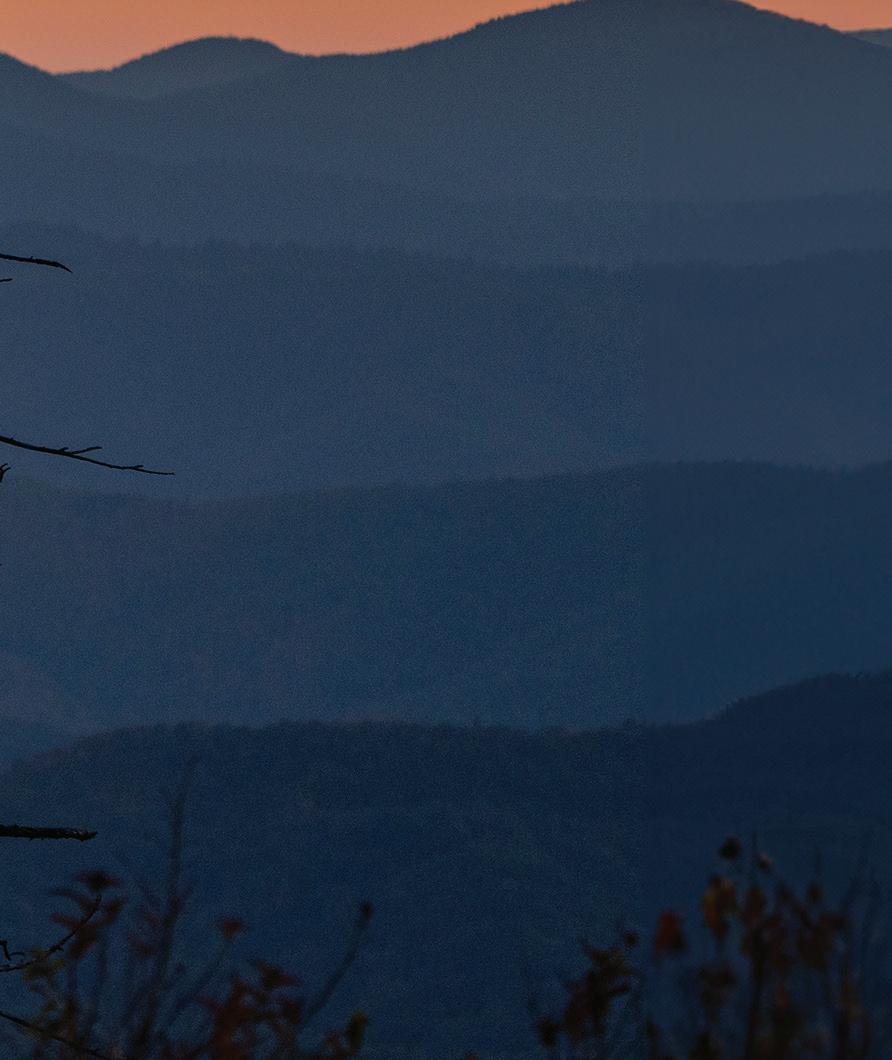




purpose, and I’m always looking for the next bike I need.
My Peak Race Moment: When I was a rookie, I got selected for the Pan American Games. I was working two jobs, and desperately needed a breakthrough as an athlete. I trained so hard for that one. Despite cramping on the last lap, I came through with a win and it changed my trajectory. But more than that, it changed my mind about what was possible.

North Carolina native Cashion Porter-Shirley was only 15 years old when he attempted the 2020 Green Race, a nail-biting kayaking competition in the bouldercongested “Narrows” section of the Green River. He took fourth place in the juniors division that morning. He also found his competitive spark.
Fast forward to today, and PorterShirley has competed in the 2022 International Canoe Federation Freestyle World Championships in England, won first place in the plastic boat division during the 2023 Gauley Animal Race, and ranked in the top 10 in the 2024 Little White Salmon Race. Still, he strives to race faster, better, and bigger.
“I have yet to compete in a major race in which I finish and feel absolutely stoked about it,” he admits. “But when that happens, it will certainly be a moment to remember.”
How I Train: I do flatwater training, running, and Vinyasa yoga. This format allows me to train wherever as long as I have my running shoes and a kayak.
I Eat: My diet is pretty fluid as a result of always being on the road. I try to eat enough protein to fuel muscle growth and recovery, and then I go pretty heavy on the carbs— rice, potatoes, fruits, and bread.
Piece of Gear I Can’t Live Without: With the exception of hot weather and warm water, I keep my Kokatat Icon GORE-TEX drysuit with me at all times.
My Peak Race Moment: The most significant moment in my racing career would have to be my first Green Race. It felt so fulfilling to race an event I had been dreaming of for as long as I had been kayaking.






BY LAUREN STEPP
BRADY POCKET PARK IS SMALL. LOCATED at the confluence of Brady Avenue and Howell Mill Road in Atlanta, the park clocks in at 2,300 square feet—about the same size as the average single-family home in America.
Tiny as it might be this gathering space is part of a massive movement sweeping the Southeast.
According to Adeline Collot, program director at the Upper Westside Community Improvement District in Atlanta, an increasing number of cities are downsizing their public greenspaces as land becomes more scarce and expensive. What results are “pocket parks”—small-scale recreation areas tucked into alleyways and street corners where community members can read in the shade, play frisbee, or stretch after a run.
“A pocket park, or parklet, is a small publicly accessible gathering space,” Collot says. “Think of it as a micro-park, usually no more than a few thousand square feet.”
Collot’s team partnered with public, private, and philanthropic entities to build Brady Pocket Park in 2019. Previously, the
2,300-square-foot parcel was mostly asphalt. But with some elbow grease and vision, they transformed the lot into a smartly appointed space with chairs, bench seating, and greenery.
Additional projects have followed. There’s the Huff Hill Transit Parklet, a 350-square-foot sitting area tucked off the main drag. There’s also the Metropolitan Atlanta Transit Authority (MARTA) Mobility Pocket Park, a 0.1-acre parcel furnished with picnic tables, a swing, and cornhole boards.
“Each pocket park fits into our urban fabric and helps create a sense of place,” says Collot, who describes these communal spaces as a “solution to filling the park deficit.”
Lincoln Larson, an associate professor of parks, recreation, and tourism management at North Carolina State University, seconds this view. “Pocket parks,” he notes, “represent an innovative solution for cities that are trying to think of new ways to revitalize vacant or deteriorating spaces.”
Pocket parks are not a new solution. These community spaces began emerging in Europe in the 1940s.
Desperate to restore urban areas wrecked by World War II, cities started building neighborhood parks. But since labor and materials were limited, they kept the parks pretty small—the size of a vest pocket, one might say.
In the early 1950s, this concept rowed its way across the pond and caught the attention of American city planners. By 1965, New York City had 18 pocket parks and 200 more in the planning phase. Meanwhile, Philadelphia had 60 in operation and another 60 in the works.
Today, more cities than ever are incorporating pocket parks into their designs. Just last summer, the Myrtle Beach Downtown Alliance in South Carolina announced plans to transform a vacant lot into a mini-park with a community library; Raleigh, N.C., unveiled a whimsical, parking spot-sized space with mushroom stools and a colorful mural; and the West Virginia city of Wheeling received grant funding to turn an unoccupied alley into a tiny sitting area.
This increased interest in pocket parks comes from a place of practicality: Because undeveloped property is limited, cities must make do with brownfields, utility and public right-of-ways, and other


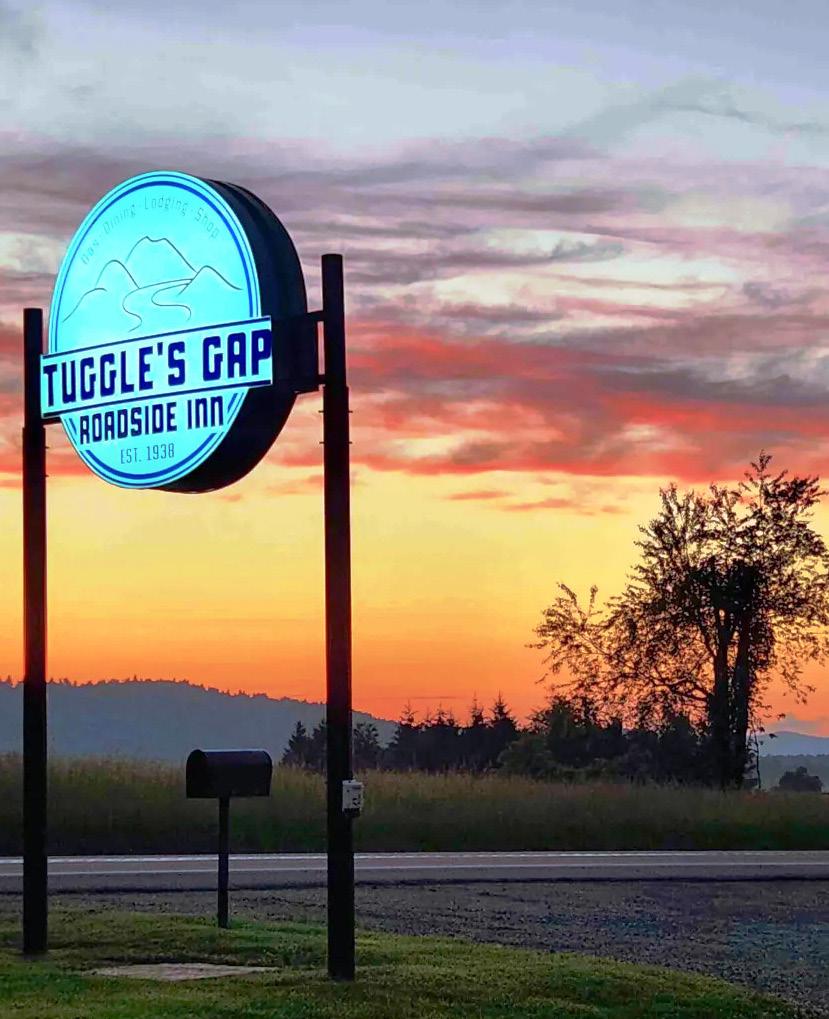

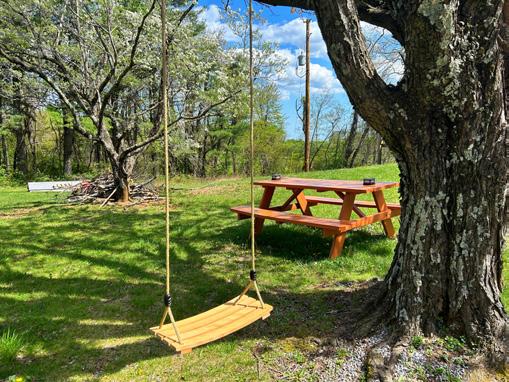
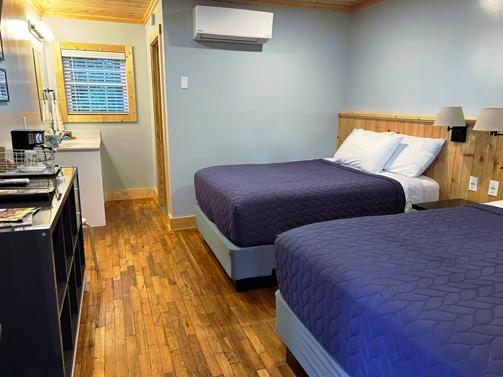







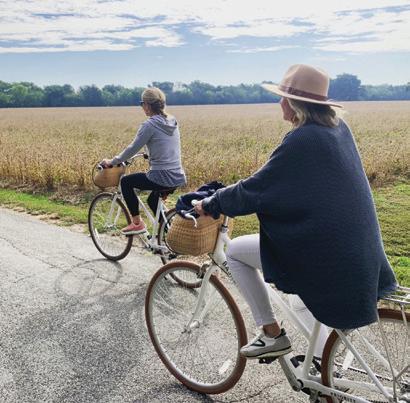

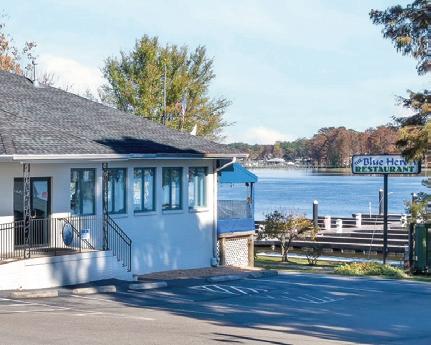
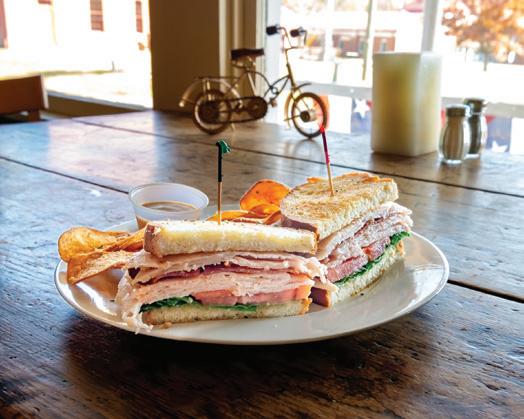








awkward slivers of land. But city planners are also realizing that pocket parks can make the outdoors more accessible. That’s according to Scottie McDaniel, an assistant professor of landscape architecture at the University of Tennessee, Knoxville.
As McDaniel explains, “Public space is not distributed evenly across urban neighborhoods.” Because of redlining and racial covenants, whiter, higher-income areas tend to have better, more accessible parks. Consequently, about one in three Americans don’t have greenspace within a 10-minute walk from home, as reported by the Trust for Public Land.
McDaniel sees pocket parks as an “opportunity for balancing outdoor public space across the urban environment.” In other words, these micro-parks have the power to bring outdoor recreation to underserved neighborhoods.
Why does this matter? Because improved park access is good for everyone. Studies show that people who live near a pocket park tend to exercise more and have less stress. Pocket parks can also lower crime rates and decrease traffic. They can help the planet, too.
“A series of pocket parks have the
potential to contribute greatly to our urban diversity of flora and fauna,” says McDaniel. “They can also improve our stormwater systems by slowing, holding, and cleaning water within the urban fabric.”
All this to say, pocket parks are tiny but mighty. Collot has learned this firsthand during her time heading off projects in Atlanta.
“Creating pocket parks is like choosing the right accessories to go with an outfit,” she says. “They can really elevate an area despite their small size.”
What does the perfect pocket park look like? We chatted with four experts to find out and then roamed the region looking for itsy greenspaces that checked all the boxes.
Franklin, North Carolina
Pocket parks should be designed to “match the local culture,” says Aaron Hipp, a professor of community health and sustainability at North Carolina State University. The Women’s History Park in Franklin, N.C., does just that.
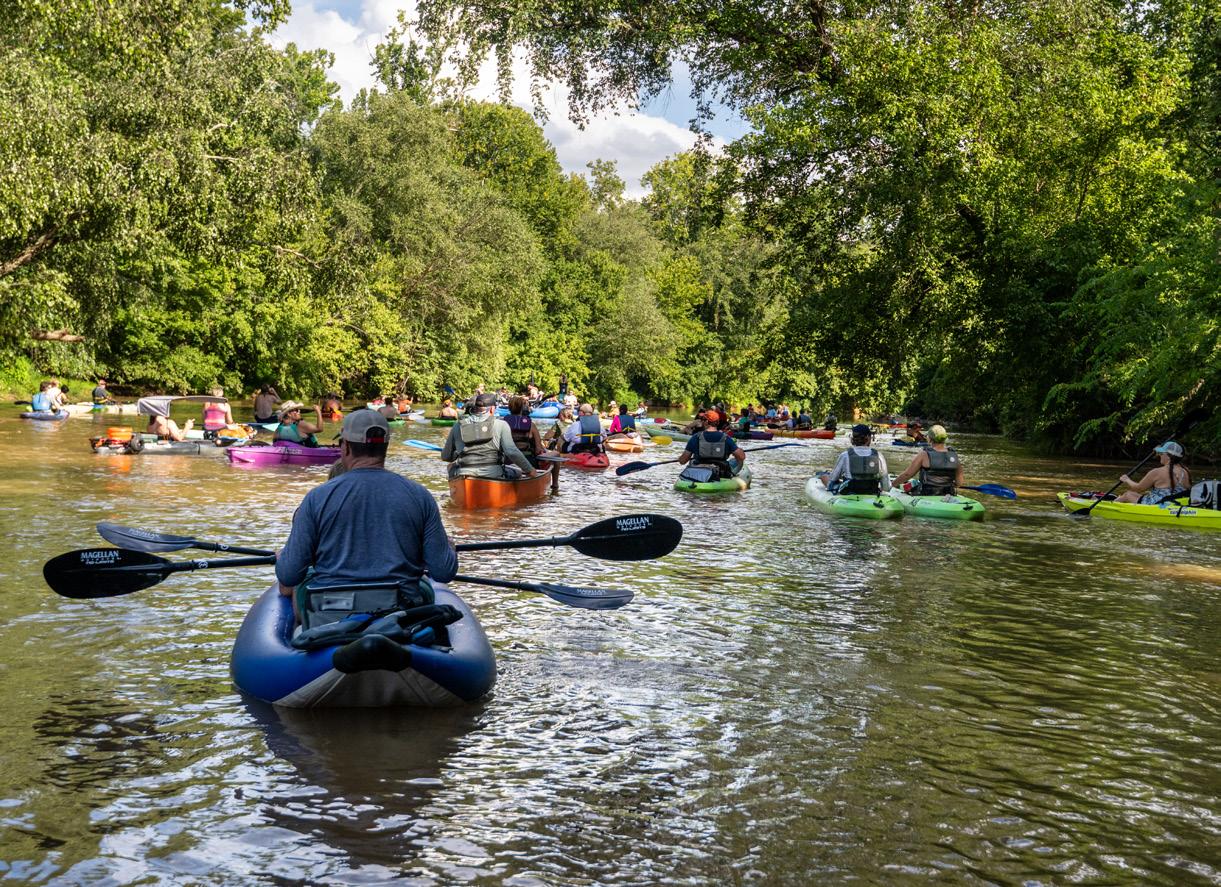


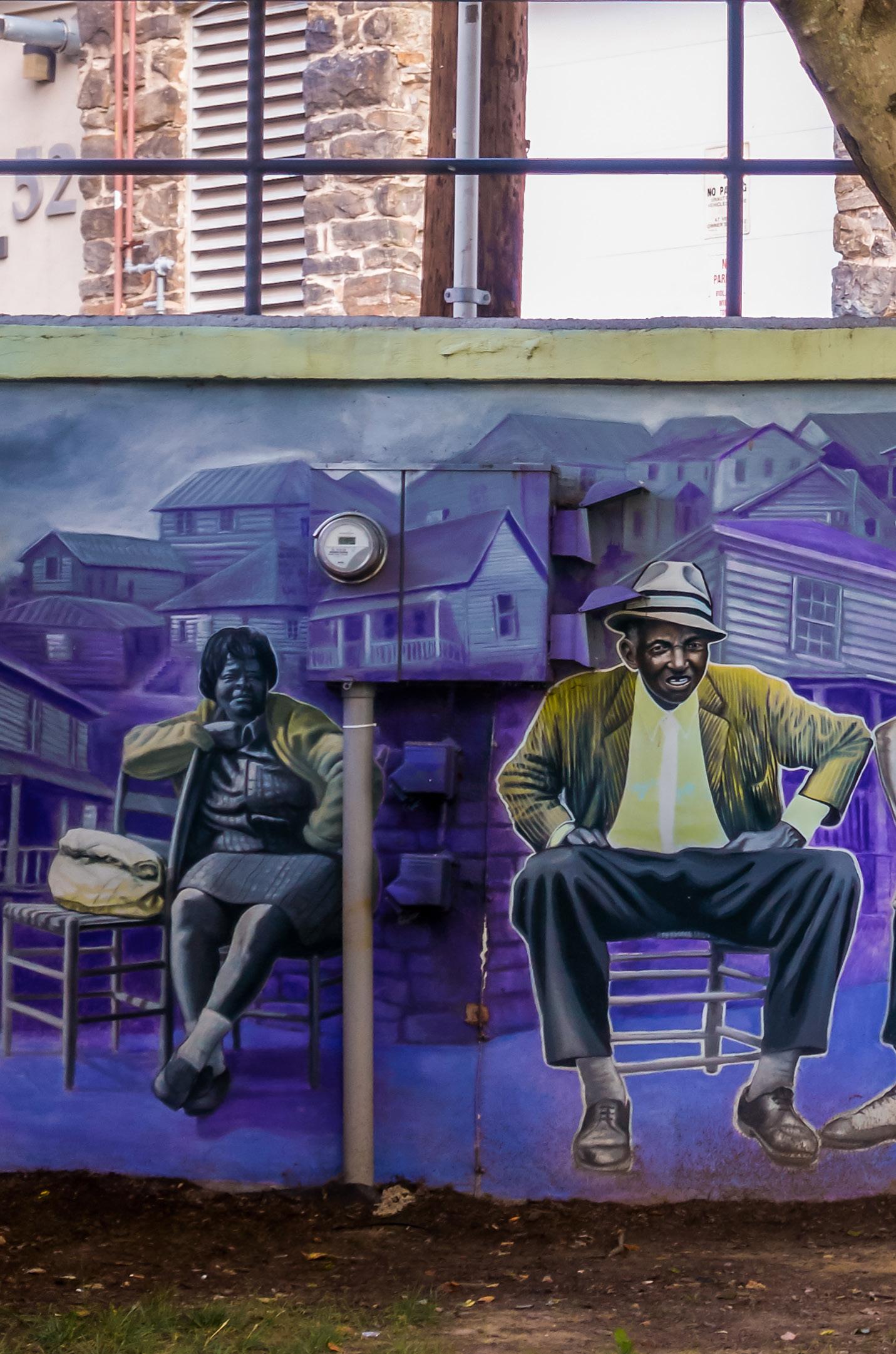



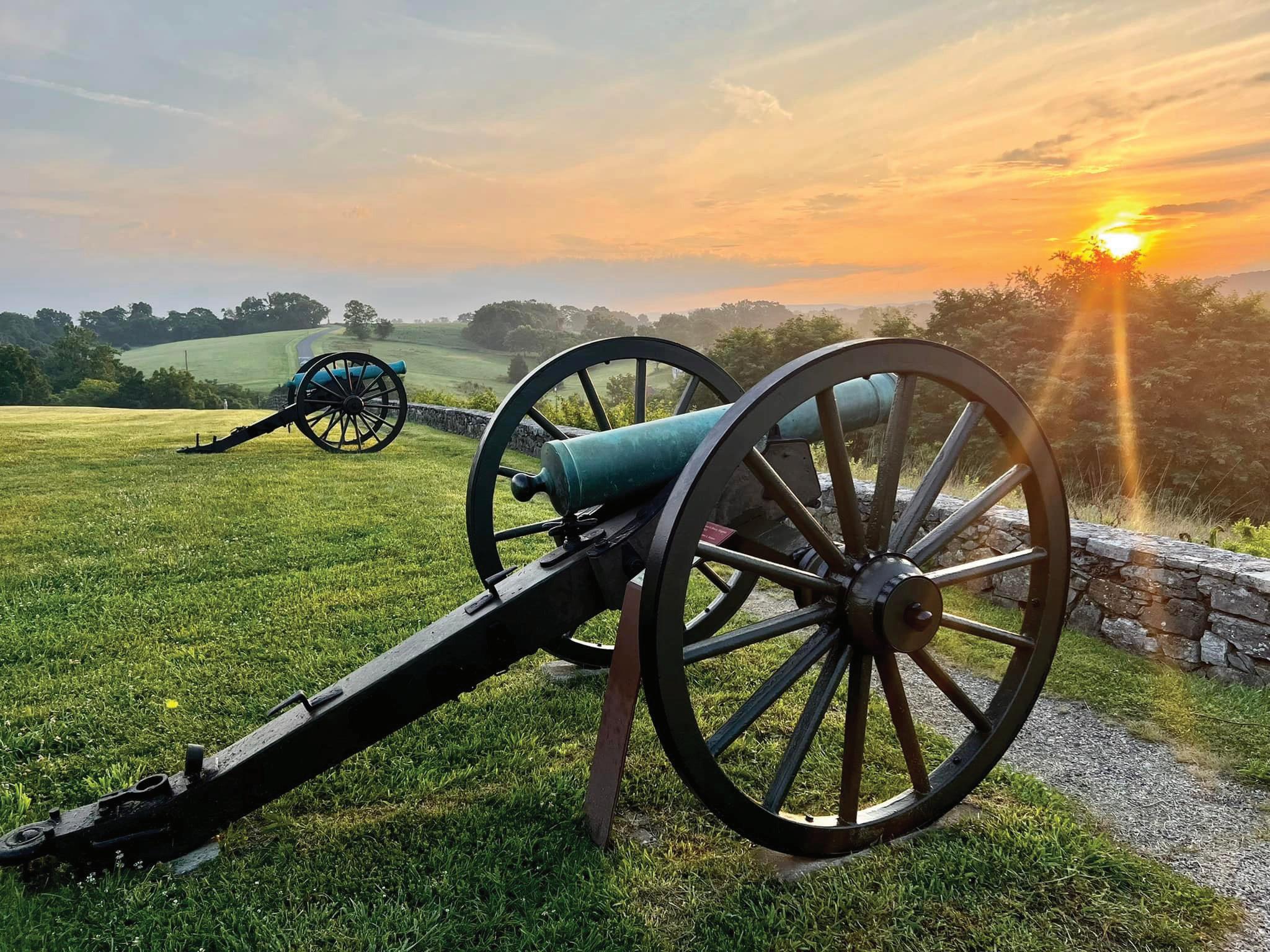

A pocket-sized pavilion nestled in the heart of Franklin, the park features “Sowing the Seeds of the Future,” a sculpture of a female pioneer, enslaved woman, and Cherokee matriarch who were all connected by a plot of nearby land. The space also serves as the trailhead for the Women’s History Trail, an educational footpath winding through town.
Knoxville, Tennessee
Pocket parks should “provide spatial variety,” says Scottie McDaniel, an assistant professor of landscape architecture at the University of Tennessee, Knoxville. Put plainly, they should look nice.
Everly Brothers Park, a tiny tribute to American rock duo Don and Phil Everly, checks that box with brick pathways, neatly manicured lawns, a small stage, and a border of sumac trees. The City of Knoxville has also installed informative plaques so visitors can learn more about the musicians.
Atlanta, Georgia
Pocket parks should serve the unique needs of the surrounding community, says


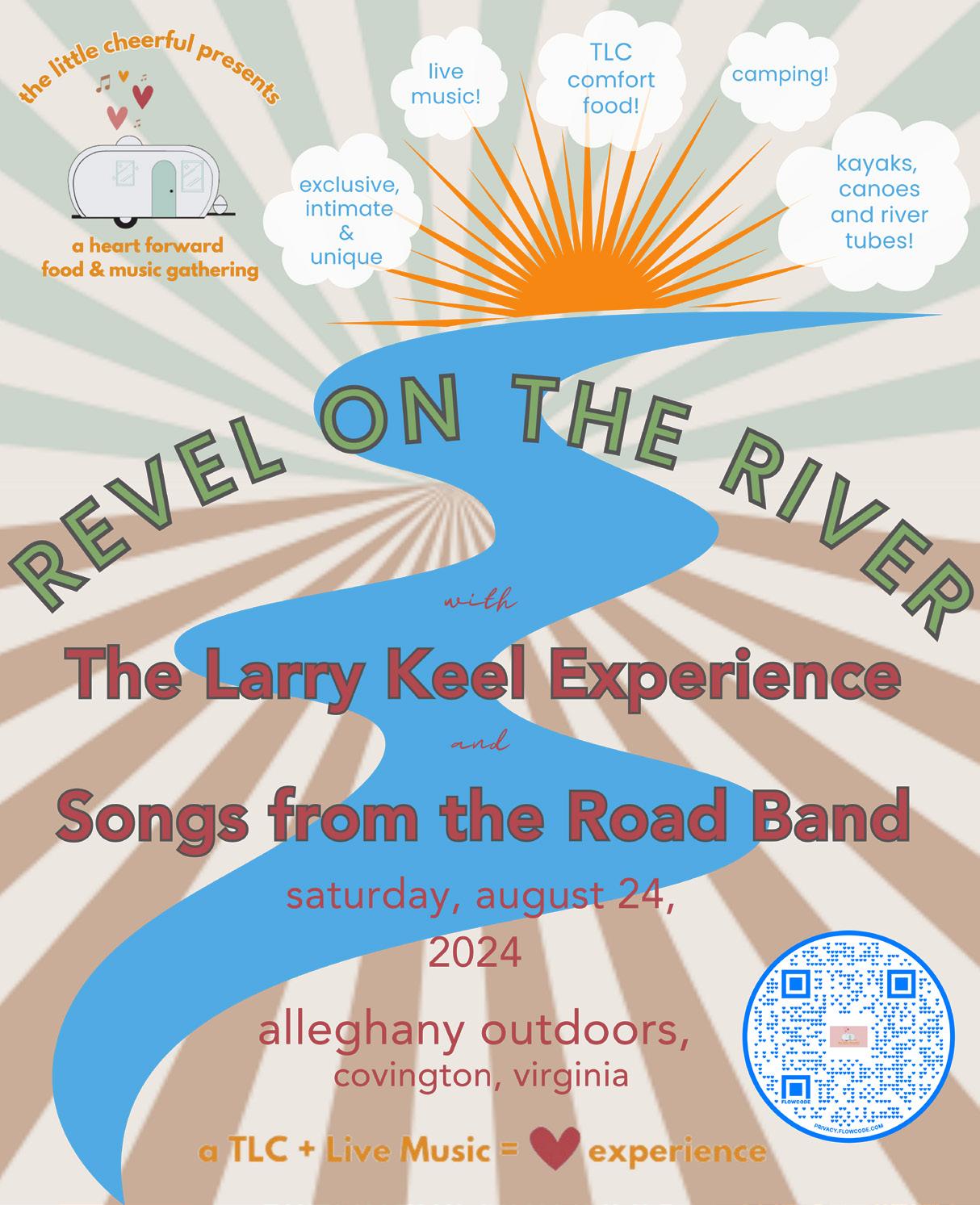


Adeline Collot, program director at the Upper Westside Community Improvement District in Atlanta. Howell Junction Pocket Park answers that call and then some.
Outfitted with bike racks and a bike tune-up station, this 3,500-square-foot space caters to city dwellers who cycle. After pedaling through rush hour, twowheeled commuters can tinker with their rigs, eat a snack on the custom bench, or just catch their breath under one of the 13 newly planted trees.
Pocket parks should be accessible, says Trenda Leavitt, a licensed landscape architect who went to great lengths to meet accessibility standards when designing Union Street Pocket Park in Danville.
“We achieved universal access with a glass-enclosed elevator, which has a small footprint…and is integrated into custom fabricated steel stairs,” she explains.
According to Leavitt, the elevator is a “beautiful means of accessing the park,” which packs a punch with lots of modern seating, a small grove of trees, a fountain, and other cool features.


FOR THE SECOND YEAR IN A row, East Tennessee State University (ETSU) has been voted the Top Adventure College by Blue Ridge Outdoors’ readers, and for good reason. ETSU is located in the Appalachian highlands, an outdoor lover's paradise close to Boone Lake, Worley Cave, Cherokee National Forest, and Roan Mountain State Park, and school officials are dedicated to providing adventure opportunities for all students.
“In the late 1990s, the director of campus recreation John Walker had the vision that ETSU with its ideal location in the Appalachian Mountains could have a premier Outdoor Adventure Program in collegiate recreation,” says Kari Osborne Albarado, the school’s current director of campus recreation.
From there the vision was passed onto Dave Mueller who “lead the Outdoor Adventure Program and much of what we see today is a result of the dedication of Mueller,” according to Albarado.
Throughout the 2000s, ETSU’s Outdoor Adventure Program grew with the addition of the Basler Center for Physical Activity and a climbing wall, along with easily accessible gear rental, Buc Bikes, and the Basler Challenge Course. More recently, the school has added new programming with a grant from the Tennessee Wildlife Resource Agency to introduce fly fishing to students.
As the Outdoor Adventure Program has grown, ETSU staff focus on using it to help students
BY LAURA FORREST HOPFAUF
develop during their college years.
“We see outdoor programming as having a positive impact on the student’s sense of self, confidence, and problem-solving skills,” Albarado says. “The ability to make time for recreation and physical activity is an important component to the overall well-being of the student.”
Recent graduate Madalyn Herrmann confirms this, saying “Having access to free gear made it possible for me to get out of my apartment on the weekends and enjoy what the Appalachian Mountains have to offer. This kept me from being cooped up increasing my chances of becoming depressed.”
Through ETSU Madayln wasn’t just able to get outdoors during college, she was also able to find a career path that aligned with her love of the wild. “I grew up loving the outdoors but never knew there was a major that could give me the opportunity to work outdoors until I got to ETSU. I was not happy with my first choice and I’m so glad I was able to find a major that matched my passion,” Herrmann shares.
Now Hermann works with Wild South, a nonprofit that aims to preserve wild lands.
Xavier Hurley, a current student at ETSU, credits the university’s Outdoor Adventure Program with developing his love for the outdoors. During his time at ETSU, Hurley has found his favorite hobby, rock climbing, and has been provided with ways to keep both physically
and mentally healthy throughout his undergraduate years.
“For me, the Outdoor Adventure program contributed heavily to the upkeep and improvement of both physical and mental health,” says Hurley, who’s also picked up whitewater paddling and backpacking through the program. Through introducing me to brand new outdoor hobbies, I now have fun physically challenging activities to enjoy both on my own and alongside Outdoor Adventure. Without Outdoor Adventure, I would have never learned how to do any of these things and missed out on amazing experiences that I will remember as some of my best memories in college.”
Both Herrmann and Hurley emphasize how the Outdoor Adventure Program doesn’t require students to have prior wilderness knowledge and experience.
Hurley says, “Outdoor Adventure can provide outdoor experiences to both students who have not had the chance to experience the outdoors on their own and students who already have outdoor knowledge, as the location of the university lends itself greatly to most outdoor activities.”
Herrmann supports this, adding “Anyone can go outdoors and enjoy them. Even if you don’t know what you’ll enjoy ETSU has many opportunities including workshops, hiking trips, and group outdoor activities so you can try out different activities that you might have never
had the chance to do for free.”
This kind of inclusion creates love for the outdoors across the student body while cultivating relationships that transcend typical college cliques through trips into the wild that unite a diverse group of students through shared outdoor experiences.
“I see it as being a unique experience of bringing students from different backgrounds together to share a common experience in which they will experience challenges as a group,” Albarado adds. “Most trips are around 10-12 students and are led by student trip leaders. Spending a weekend camping, going whitewater rafting, or canoeing with other students is a bonding experience for the group that attends—many of which do not know each other before leaving campus. You see friendships develop as a result of these shared experiences.”
Blue Ridge Outdoors’ annual Top Adventure College contest places 32 colleges and universities against each other in a bracketstyle competition. This year, more than 7,000 votes were cast by readers. East Tennessee State University took the first-place title based on academic curricula, outdoor programming, eco-friendly initiatives, and access to adventure. The runner-up was Appalachian State University, and the contest was sponsored by Bridgedale.

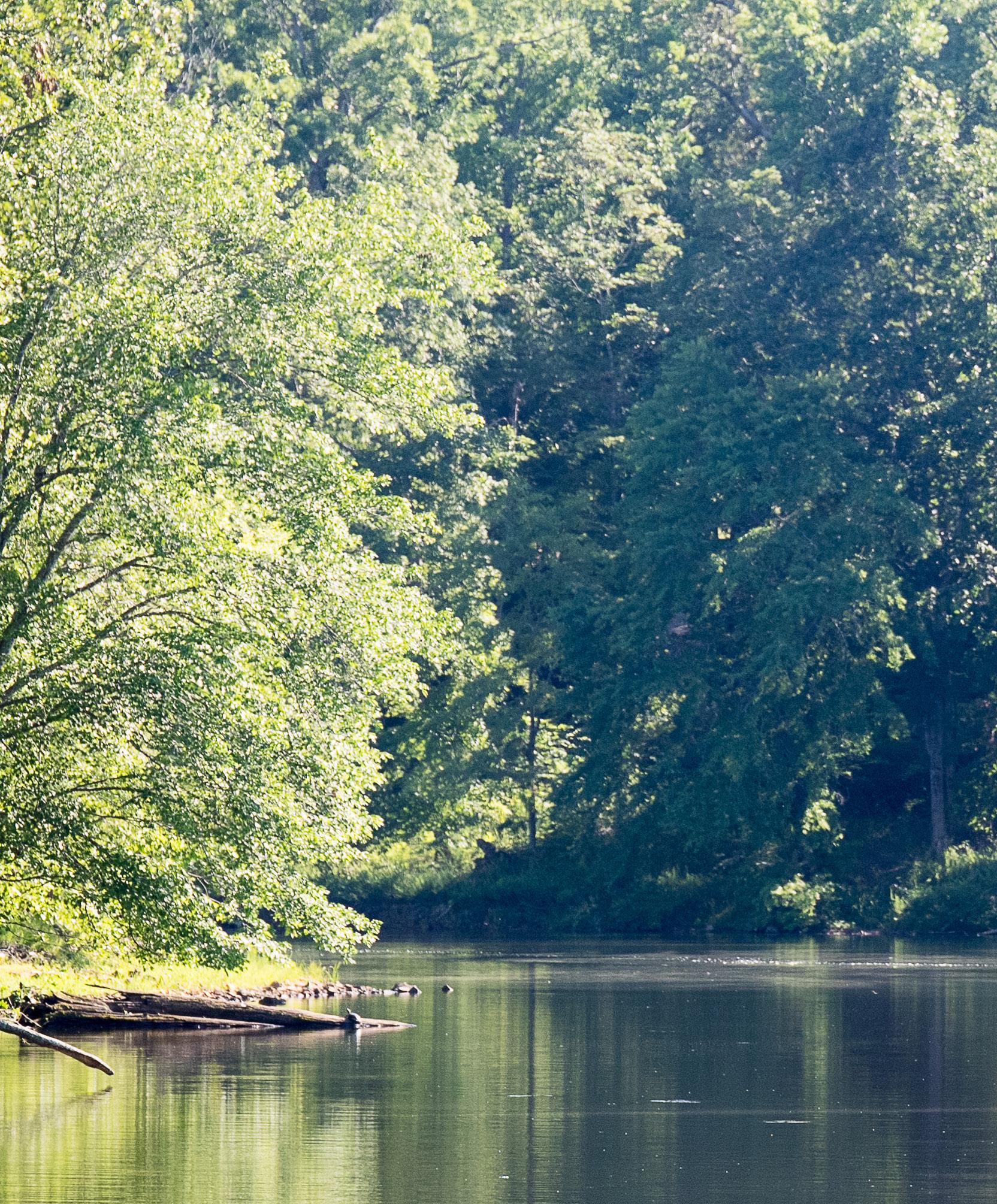
Adventures at a Forgotten National Recreation Area on the Tennessee-Kentucky State Line
BY MIKE BEZEMEK

I WAS STANDING OVER MY MOUNTAIN BIKE, TAKING A break on a forested bluff above blue water. It was a sunny fall day, and the foliage was mostly green with some early colors. In the reservoir below, several motorboats were making curved wakes. In the distance, a river barge was inching toward a lock. And on either side of me, there was nothing but fun singletrack with almost no one riding it.
For years, while driving interstates between the Southeast and points west, I passed intriguing brown signs for Land Between the Lakes National Recreation Area. But whenever I searched online, the vibes were mostly reservoirs, shorelines, and motorboats. Maybe an occasional horseback rider or hunter. So we kept speeding past—with mountain bikes, hiking shoes, and kayaks—looking for other places.
Yet LBL had some promising stats. Over 170,000 acres of wooded peninsula, 300 miles of undeveloped lakeshore, and 500 miles of trails. Frankly, such big numbers with little explanation can be a red flag. If it was good to go, everyone would already know about it, right? Not always. National recreation areas often surround reservoirs, which tend to become the focus, making inland activities harder to find. But sometimes, there are worthy adventures to discover.
In the mid-20th century, the TVA built a pair of large dams on the Tennessee and Cumberland Rivers, creating Kentucky Lake and Lake Barkley. The peninsula was acquired by eminent domain and left in a natural state for outdoor recreation. In 1998, management of LBL was transferred to the U.S. Forest Service. Last summer, on a road trip to the Ozarks, I dropped by with my camper and came away impressed. So, that October, I returned for tent camping in cooler weather. During these two visits, I studied maps, asked around, and hit the ground for a broad survey of what the area offered.
During my summer visit, the Canal Loop proved to be the best mountain biking at LBL. This 14-mile trail system offers fast cross-country singletrack through rolling hills with enough jumps and snappy turns to keep it interesting. Four connectors segment the full trail into shorter loops, allowing riders to customize their mileage or reverse certain sections.
The trailhead is at North Welcome Station on the Kentucky side of the rec area. Each time I went, I encountered plenty of lake views and just a handful of other bikers. The cooler temps were greatly appreciated during my fall trip, which allowed me to ride laps in all directions at blazing speeds. A fun trail for beginning mountain bikers to build skills and experienced riders to build their legs.
Occasionally, I stopped to chat with the rare passerby. Each time we marveled at the surprising quality of the trail. With one instant MTB pal, we briefly rode a short part of the intersecting North/South Trail. This mixed-use route traverses the entire length of LBL, but it has some quirks. The northern 31 miles are mostly singletrack for hikers and bikers. The southern 28 miles are mostly old doubletrack roadbeds, open



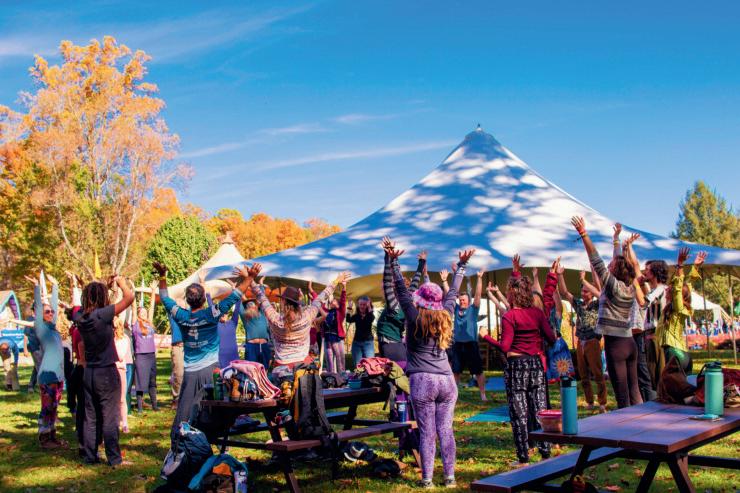

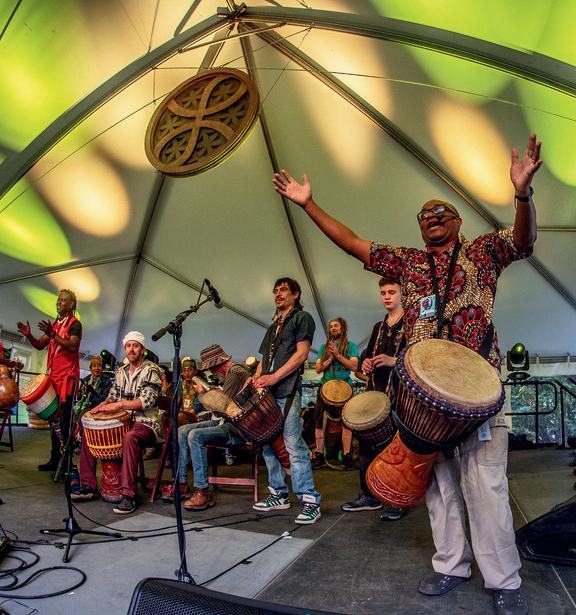
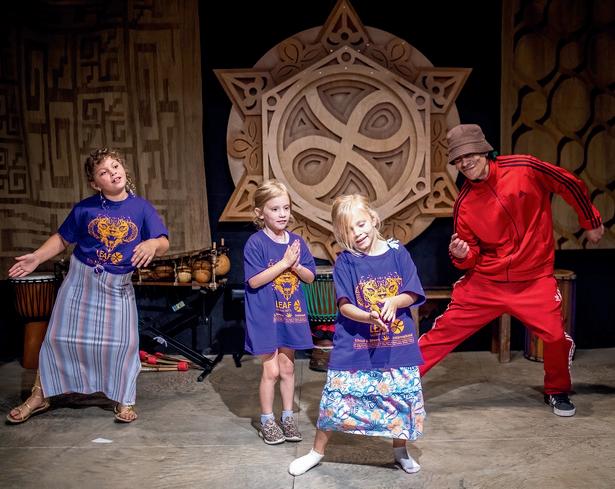
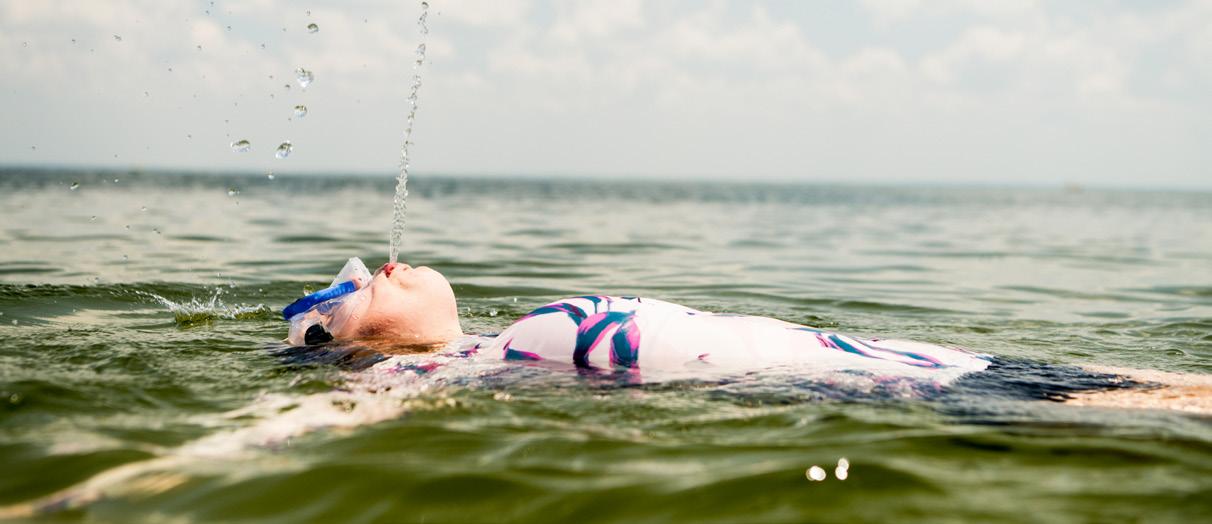



only to hikers and horses—no bikes. I crossed this long-distance trail a few times, and I remain curious to see more.
On this trip, I stayed at nearby Hillman Ferry Campground, a large public camping resort. That put me in 30-minute striking distance to the river city of Paducah. One night, I picked up food at Just Burgers, a local staple, and took it to Dry Ground Brewing Co. They have great beers and are located inside the old Coke Plant, a historic landmark. Another night I stayed closer to northern LBL and checked out the scene at Between the Lakes Taphouse in Lake City. While I was chatting with an aspiring mountain biker at the bar, an amateur Elvis impersonator took the stage for an a cappella session. When I asked if he was a hired performer, the bartender shook her head. “No, he just does that a lot.”
The moment I stepped inside the Golden Pond Visitor Center, I began to understand why the inner peninsula is mostly forgotten. On a wood-paneled wall, there were dozens of paper brochures. Seemingly one for each highlight in this vast recreation area. There’s even a planetarium in the attached dome theater. Unlike an NPS unit, LBL doesn’t have a detailed brochure or easy-to-consult website for figuring out what to do. It's an outdoor park still waiting to be discovered.
A few times I hopped on my gravel bike to ride the Central Hardwoods Scenic Trail. This 11-mile multiuse path is open to pedestrians and cyclists, crossing the peninsula from lake to lake. The easternmost three miles are paved next to the highway. I preferred the western side, with just over eight miles of crushed gravel rolling through hilly old-growth forest. My turnaround point was the Eggner Ferry Bridge, where I took shady breaks by the water. This was a fun ride, and almost any bike would work.
Highlights abound in this central part of the rec area. Just north of Golden Pond is the Elk & Bison Prairie. One summer evening, I paid the small fee and drove the three-mile loop through the 700acre wildlife preserve. As dusk arrived, a line of bison marched along a road with less than a dozen cars, past meadows filled with grazing elk and blinking fireflies.
Another day I hiked the Nature Station Trail System. The 4.6-mile Honker Trail was a moderate to easy path through woods to the
edge of Lake Barkley and across Honker Dam, which impounds a large wetland filled with water lilies and birds. The 2.2-mile Hematite Trail is a comparable loop around a smaller lake. Afterward, I visited the Woodland Nature Station, an educational center with outdoor gardens and a small rehabilitation zoo that includes red wolves.
Traversing the entire LBL peninsula, the Woodland Trace National Scenic Byway stretches nearly 50 miles north to south. Just past the state line, I stopped at an LBL historic site, the Great Western Iron Furnace. In the mid-1800s, iron ore pits were dug in the area, called Between the Rivers at the time. A total of eight limestone slab furnaces were built to turn the ore into iron ingots, which were shipped on barges to market.
For my final two nights that fall, I set up at Piney Campground. It may have been the fall colors around the reservoir inlets, but this was my favorite campsite at LBL. While my legs were dead from three laps at Canal Loop the day before, I decided to tough out a final day ride.
My goal was to explore the Fort Henry Trail System. The mix of singletrack and doubletrack routes follow an 1862 Civil War march, when Ulysses S. Grant led a Union ground force eastward in pursuit of retreating Confederate troops. Today, the area is open to hikers and bikers, yet I was the only person around on a mild Thursday in mid-October. The unmaintained trails were overgrown in places. Good for adventurous explorers, but watch out for poison ivy, cobwebs, and ticks. The best options I found were around the Devil’s Backbone Natural Area, including Artillery Trail and the ridgeline Devil’s Backbone Trail.
For a final dinner out, I went to Blue’s Landing in nearby Buchanan, Tenn. In one night I saw more people at this popular Cajun restaurant and live music bar than on all four trails combined. My main takeaway is that most LBL visitors seem to congregate at shoreline campgrounds, leaving nearly empty woods for those who venture off.
The last southern highlight I visited was just outside the rec area at Fort Donnelson National Battlefield. This one’s somewhat unique among military parks given that you can walk through the site on several miles of paths. After Union troops surrounded the Confederates inside Fort Donnelson, a surrender was finalized inside the restored Dover Hotel, which has become a small NPS museum.
As I drove east, I called my wife to report. It was a hidden peninsula filled with outdoor opportunities. The main question was when we might return to the lost Land Between the Lakes.






On June 15, 1936, with the help of the Civilian Conservation Corps (CCC), Virginia opened six state parks, combining outdoor recreation with natural resource protection. Now expanded to 43 parks, the system is managed for natural and historic preservation and offers diverse recreational activities, including stunning scenery, historical sites, boat access, camping, cabins, and family-friendly nature and history programs.
for camping, boating, and hiking, providing a peaceful escape into nature.
The Blue Ridge region, rich in history and natural beauty, has been home to diverse cultures for thousands of years. From Native American tribes to European settlers, its mountains and valleys have witnessed pivotal moments in American history, including the Revolutionary and Civil Wars, the Industrial Revolution, and unique inventions. Today, these destinations’ scenic trails, lush forests, and flowing rivers invite exploration, offering a glimpse into the past while celebrating the enduring connection between its people and the great outdoors.
The original six State Parks in the commonwealth each offer something special. Douthat State Park, nestled in the Allegheny Mountains, features stunning mountain views, over 43 miles of hiking and biking trails, and a picturesque 50-acre lake, making it a haven for outdoor enthusiasts. Fairy Stone State Park is renowned for its unique fairy stones—rare mineral formations that attract collectors and visitors alike. The park also boasts a 168-acre lake, ideal for fishing, swimming, and boating.
First Landing State Park, originally called Seashore, combines beach and forest environments along the Chesapeake Bay. It offers opportunities for swimming, hiking, and exploring diverse ecosystems, including maritime forests and lagoons. The park, where English colonists first landed in 1607, has seen navigation by Native American canoes, Colonial settlers, 20th-century schooners, and modern cargo ships. Hungry Mother State Park is a serene retreat with a 108-acre lake surrounded by lush woodlands. It’s perfect
Staunton River State Park offers a variety of water activities on the Dan and Staunton Rivers, which played a crucial role in transportation of tobacco in the 1810s. This park is also the first state park in Virginia to be designated an International Dark Sky Park and is ideal for stargazing. For those interested in Earth’s geological history, Westmoreland State Park, set along the Potomac River, is famous for its striking cliffs and opportunities for fossil hunting. Visitors can explore the park’s trails, enjoy panoramic river views, and engage in various water sports. These parks collectively showcase Virginia’s commitment to preserving natural and historical treasures while providing diverse recreational activities for residents and visitors.
VirginiaStateParks.gov
• Pocahontas State Park: Was initially managed by the National Park Service as a recreational demonstration area until it became a state park in 1946. Here, You can learn more about the CCC’s impact on Virginia State Parks at the Civilian Conservation Corps Museum.
• Twin Lakes State Park: Both Prince Edward and Goodwin Lake dams, created by one of the few all-black CCC divisions in the 1930s, originally operated as separate recreation facilities until the Civil Rights Act of 1964 led to their integration.



Nestled in the heart of West Virginia, Randolph County boasts a rich tapestry of history and natural beauty. Established in 1787, the county has deep roots in American history, from Native American lore to the Civil War. It is also a haven for outdoor enthusiasts, with stunning landscapes in the Monongahela National Forest and scenic trails like Bickle Knob and Gaudineer Knob. Whether delving into its storied past or immersing in its natural splendor, Randolph County offers a unique blend of history and outdoor recreation.
Founded in 1890, Elkins, West Virginia, was established by Senator Stephen B. Elkins. The town’s strategic location for the West Virginia Central and Pittsburgh Railway, which Elkins played a major role in developing, spurred its establishment. The railway brought significant economic growth, transforming Elkins into a hub for the timber and coal industries.
Visit the Elkins Depot Welcome Center for maps and the Elkins Historic Walking Tour to guide your historical adventure through Randolph County. Explore the historic 1908 depot built by the
Western Maryland Railway Company. From Thursday to Sunday, enjoy a scenic excursion to the High Falls of Cheat on a vintage diesel engine with the Durbin and Greenbrier Valley Railroad for an unforgettable experience. Or, travel the old-fashioned way and hike to this remote waterfall on a challenging 12.6-mile loop! Don’t miss the historic Darden Mill in downtown Elkins. Built in 1902 as the Elkins Milling Company Plant, it now houses the Appalachian Forest Discovery Center and the West Virginia Railroad Museum, featuring compelling rotating exhibits.

The town of Beverly preserves its historical heritage with numerous 18th and 19th-century buildings. Visit the Beverly Heritage Center, open Wednesday to Sunday, 10 am to 5 pm, to explore Beverly’s history and the First Campaign of the Civil War. Get visitor information, a gift shop, and a self-guided tour brochure to discover sites like Beverly Cemetery and the Lemuel Chenoweth House
Check out Rich Mountain Battlefield’s historic sites sprawled over 440 acres of scenic terrain. At the Hart Farm, perched atop Rich Mountain, delve into the heart of the conflict. Wander through historical markers and interpretive signs detailing the battleground’s
story. Follow a serene half-mile trail, uncover Lander’s Rock, and discover soldier-carved graffiti and remnants of the Hart family’s spring house. Adjacent, the Field of Fire offers a park and pavilion for events, with a connecting hiking trail to Camp Garnett.
Helvetia, founded by Swiss immigrants, preserves its heritage through agriculture, dairy farming, cheese making, and traditional crafts. The town features Swiss architecture and hosts events like Fasnacht, a pre-Lenten festival that celebrates its unique cultural legacy. Embark on Helvetia’s Historic Hiking Trail, a 2.5-mile public trail that follows the path of Helvetia’s original settlers. Or, take a stroll
around Helvetia or opt for an hour-long guided walking tour with local guide Dave Whipp. Visit Swiss Roots, where the Helvetia Post Office has served the community for 139 years, and explore the Fasnacht Mask Museum, which preserves artifacts and history of the renowned Fasnacht celebration.
ElkinsRandolphWV.com/ itineraries/
• The Mingo (Mingwe) Native American statue stands along Route 219 at Mingo Flats in Valley Head. Early pioneer descendants erected it to honor the former village, now the site of the historic Brazenhead Inn.
• Plan your visit to Beverly during special events or living history days, such as Beverly Heritage Day in July, when reenactors and costumed interpreters bring history to life.
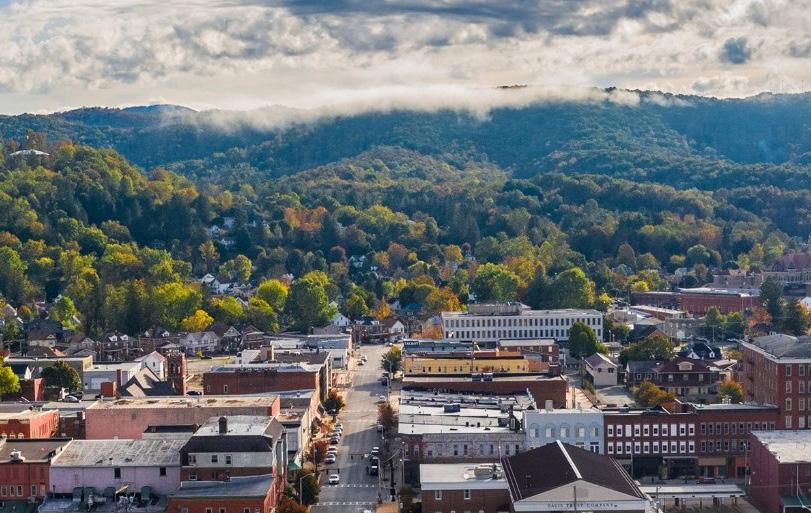
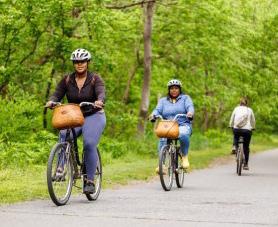
Lynchburg, chartered by the Virginia General Assembly in 1786, emerged at the crossing of John Lynch’s ferry over the James River along a vital north-south trading route. Nestled amidst hills that earned it the monikers “The Hill City” and “The City of Seven Hills,” Lynchburg has long been intertwined with outdoor pursuits and recreation opportunities. Today, it thrives as a hub for outdoor enthusiasts, offering a wealth of activities amidst its scenic landscapes.
The Monacan Indian Nation, whose ancestral home is Bear Mountain in Amherst County, were the most recent indigenous people in the Lynchburg area. They lived off the land, cultivating crops, like corn, beans, and squash, and relying on hunting and foraging.
During the Civil War, Lynchburg was spared from damage, preserving its antebellum architecture and quickly recovering. The city’s founders, mainly Quakers, promoted non-violence, gender equality, abolition of slavery, and racial justice. Lynchburg was a major military hospital center and the second largest permanent hospital complex in the Confederacy. From 1875 to 1925, it was a hub of African American life and culture, home to
Black high schools, colleges, and a thriving business community.
In April 1865, Lynchburg briefly served as the state capital. By the 1880s, it was the largest loose-leaf tobacco market in the country. In the early 20th century, the city became the largest shoe manufacturing center in the South, with CraddockTerry Shoe Corporation as its biggest employer. In the 1950s, General Electric and Babcock & Wilcox boosted the local economy, making the nuclear sector a major employer.
During World War I, Lynchburg, nicknamed “Lunchburg,” served thousands of soldiers passing through by train. In the 1950s, Randolph College housed the National Gallery of Art’s emergency collection during the Cold War, now the Maier Museum of Art. Liberty University, growing significantly after the death of founder Rev.

Jerry Falwell, Sr., in 2007, has made Lynchburg a true college town in the modern era.
Lynchburg invites you to explore its rich history through a variety of engaging outdoor sites. Start your journey at the Old City Cemetery, established in 1806, where Confederate soldier graves, a chapel, and numerous monuments offer a poignant glimpse into Lynchburg’s past. Guided walking tours, selfguided exploration, and special events throughout the year immerse visitors in this historic landscape.
For more civil war history, check out the Virginia Civil War Trails network, with marked sites and interpretive markers guiding visitors through battlefield remnants and landmarks. Historic Sandusky, a house that was a pivotal site during
the Civil War, provides guided tours and occasional reenactments, bringing to life the strategies and daily realities of that era amid serene surroundings.
Explore Percival’s Island Natural Area, where trails adorned with historical markers reveal Lynchburg’s industrial evolution, perfect for walkers and cyclists alike. For panoramic views and historical insights, follow the James River Heritage Trail, which is accessible via the Natural Area and winds along the riverbank. This trail system not only offers hiking and biking opportunities but also educates with interpretive signs highlighting Lynchburg’s cultural heritage.
Riverside Park also blends historical exhibits with outdoor activities like picnicking and hiking, featuring a 19th-century locomotive and the hull of the packet boat, Marshall.
• The lip balm product “ChapStick” was invented in Lynchburg in the late 1800’s and manufactured there well into the 20th century.
• Anne Spencer, a leading figure of the Harlem Renaissance, hosted influential Black leaders like James Weldon Johnson, W.E.B. DuBois, Marian Anderson, and Martin Luther King, Jr., at her home on Pierce Street in Lynchburg.
• Local physician Dr. Walter Johnson trained tennis stars Arthur Ashe, Althea Gibson, and Juan Farrow on the clay court beside his home on Pierce Street, recently restored with support from the United States Tennis Association.



For rainy days, head indoors to The Lynchburg Museum at the Old Court House, featuring exhibits on local people, events, and artifacts spanning from antique toys and military items to fine art, furniture, and historic costumes. The Legacy Museum also features rotating exhibitions and programs covering all facets of local African American history and culture, spanning from the first arrival of Africans in Central Virginia to the present. It hosts exhibitrelated programs and special events, particularly during Black History Month.
Experience early 19th-century life at Point of Honor, the former home of Dr. George Cabell, Thomas Jefferson’s physician. Today, this museum offers guided tours
through its elegant interiors and lush, expansive grounds. Another must-visit is Poplar Forest, Thomas Jefferson’s plantation and retreat, now hosting educational programs and recognized as both a National Historic Landmark and a Virginia History Trails site.
The James River underwent significant environmental challenges throughout much of the 20th century, plagued by severe pollution and safety concerns. However, concerted efforts at the federal, state, and local levels have led to substantial improvements in water quality. Today, the James River Association plays a pivotal role, monitoring the river daily, fostering stewardship
practices, and advocating for sustainable recreational activities along its banks.
exercise and safe social interactions, becoming one of Lynchburg’s most cherished amenities.
A landmark in Lynchburg’s environmental conservation efforts, the creation of the Blackwater Creek Natural Area began in the 1970s through the advocacy of local naturalists, conservationists, and citizens. They successfully persuaded the City Council to acquire nearly 300 acres of abandoned railroad beds and undevelopable land along Blackwater Creek. Over time, this area has been transformed into an urban wildlife sanctuary and greenway, known as a “natural wilderness area,” accessible via wide paved paths and hiking trails. During the COVID-19 pandemic, the Natural Area provided a crucial outlet for LynchburgVirginia.org
Within the Blackwater Creek Natural Area, the Ruskin Freer Nature Preserve holds a special distinction. Covering 115 acres of hardwood forests and creekside habitats in the city center, it honors Dr. Ruskin Freer, a prominent biology professor and Lynchburg College dean, renowned as the city’s leading naturalist in the 20th century. Today, the preserve features interpretive signage and plant identification resources for visitors interested in its ecological treasures.
Embark on a journey through Lynchburg’s historical treasures to uncover the vibrant stories that have shaped this city’s unique character and legacy.
• The James River Batteau Festival, a Lynchburg tradition since 1986, sees volunteers navigating historic “batteaux” down the James River from Lynchburg to Maiden’s Landing in Goochland County each June. The event kicks off with a lively boat launch from Percival’s Island, drawing thousands of spectators.
• Celebrating its 50th anniversary this year (1974–2024), the Virginia 10 Miler in Lynchburg attracts runners worldwide to its challenging 10-mile course from E.C. Glass High School to Riverside Park every September.
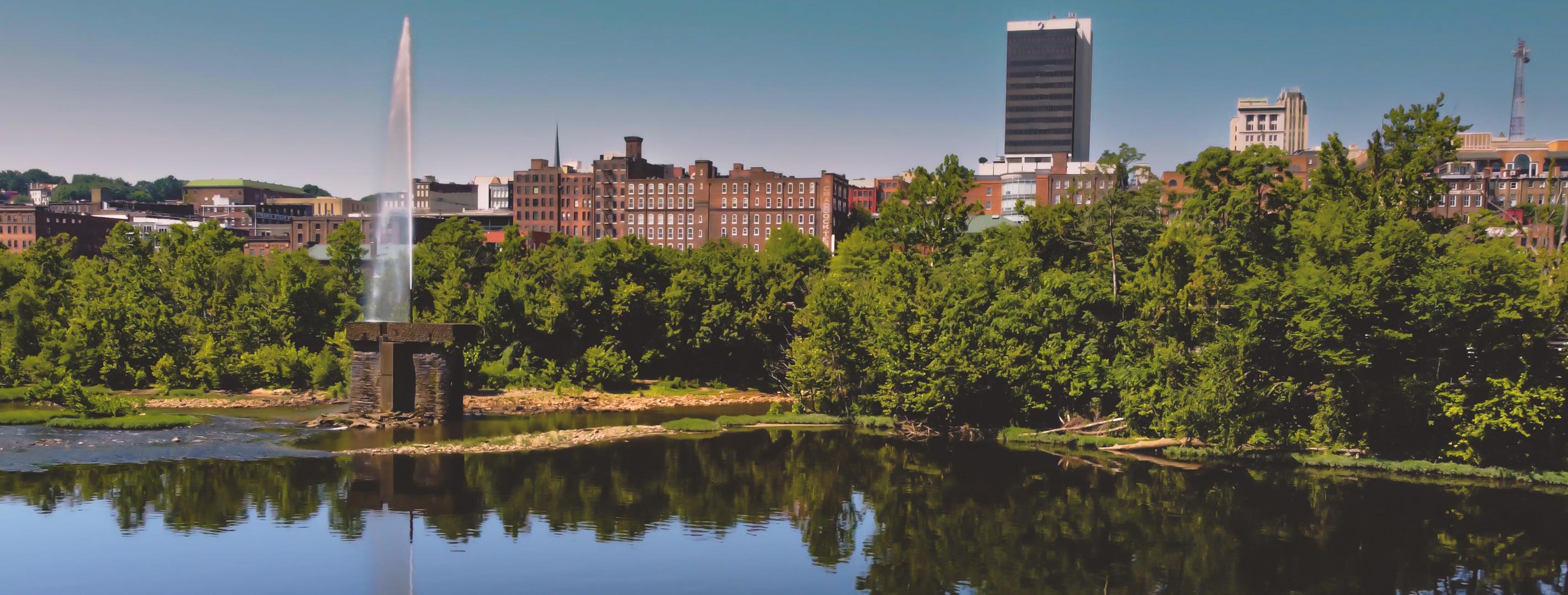
SoSi stretches throughout Danville, founded in 1793, and Pittsylvania County, founded in 1767, encompassing a rich tapestry of architectural and agricultural history. This area is a testament to centuries of development, with historic buildings that narrate tales of the past and sprawling farmlands that reflect the region’s agricultural legacy.

ABUNDANT ARCHITECTURE AND AGRICULTURE
There is so much to see, so much to do in terms of experiencing the architectural and agricultural history in SoSi! Explore Millionaire’s Row on Danville’s Main Street, showcasing stunning Victorian and Edwardian architecture. Use the Old West End Historic District Walking Tour guide to uncover each home’s rich history. Stroll through the rebranded River District, filled with dining, shopping, and historic architecture, including adapted tobacco warehouses. Visit Lady Astor’s birthplace at Langhorne House Museum and stay at The Bee Hotel, a renovated boutique hotel that was once home to the Danville Register and Danville Bee newspapers.

dining space.
For some more outdoor fun, catch an evening baseball game at Dan Daniels Memorial Park and cheer on the Dairy Daddies, a team celebrating Danville’s rich agricultural history. Explore the Ringgold Rail Trail, once a crucial Civil War transportation corridor, now a 5.5-mile historical trail perfect for walking or biking through scenic farmlands. Enjoy guided walking tours of downtown Danville or explore at your own pace using the extensive collection of historical plaques throughout SoSi. So, what are you waiting for? Discover the rich history and vibrant outdoor experiences of SoSi today!


Head to Huntington, West Virginia, for an authentic Appalachian experience at Heritage Farm. This unique destination offers a glimpse into everyday life in Appalachia from the 19th century to the present, featuring museums, re-enactments, and outdoor recreation opportunities for the whole family.
In 1973, co-founders Mike and Henriella Perry relocated from a beautiful brick home in Huntington, West Virginia, to a burnt log cabin on a 150-acre farm. Discovering old hand-hewn logs behind the farmhouse walls, they fell in love with their Appalachian ancestors and their lifestyle. Inspired by these pioneers, the Perrys developed Heritage Farm to honor their hard work and perseverance. Over 20 years, they collected authentic period materials and structures, creating a window into everyday life in Appalachia. Heritage Farm opened to the public in 1996 and has since grown, sharing stories and aspects of Appalachian life year-round.
Country Store offer treasures from the past, while the Children’s Activity Museum provides hands-on learning for kids. The Log Church is a central attraction, and the Heritage Museum, open during festivals, contains artifacts from the original museum. Experiences at Heritage Farm range from observing to participating. Guests can watch and talk with people doing traditional Appalachian tasks, such as blacksmithing, knitting, and printing. The petting zoo, nature center, and treehouse walk offer close encounters with Appalachian animals. The Adventure Park features 1,100-foot dueling ziplines, a 40-foot ropes course, a 15-foot ropes course for kids and adults, and a mountain bike park with six downhill trails.
In Chatham, historic Main Street features the courthouse, the 1813 Clerk’s Office, and the Pittsylvania Historical Society, with its extensive collection of local documents and artifacts. Dan River Falls, the reimagined textile mill formally known as Mill No.8, will soon come to life with residential living, the Riverfront Park’s Grand opening, and numerous retail and
• The Danville Museum of Fine Arts & History, a significant stop on the US Civil Rights Trail, spans 15 states and includes over 120 sites.

Today, multiple museums and experiences comprise Heritage Farm. The Progress Museum showcases life from 1850 to 1950, with various artifacts and pictures.
The Transportation Museum displays planes, trains, automobiles, steam boats, and stagecoaches. The Industry Museum highlights West Virginia’s key industries: salt mining, coal mining, and glass production.
The Doll & Carriage Museum and re-created
Overnight rentals and reception halls are available for those who want to extend their stay, and the Farm features 4 unique lodging properties for a special trip back in time.
HeritageFarmWV.com
• The Historic North Theater, originally opened in 1947 and reopened in 2012, hosts a variety of productions, festivals, and special events. DID YOU KNOW?
• In 2015, the Smithsonian Institution recognized Heritage Farm as an official affiliate, the first and only in West Virginia.
• The History Channel has filmed two projects at Heritage Farm: portions of America’s Greatest Feud: The History of the Hatfields & McCoys, and an episode of American Pickers, “Pickin’ Perry-dise.”
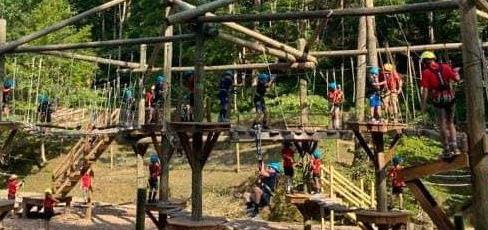


Founded in the 1740s, the City of Frederick, Maryland and Frederick County have been at the heart of significant historical events from the Colonial period, the American Revolution, the Civil War, the Industrial Revolution, and well into the 20th century. The county’s landscapes and waterways have been witness to and shaped by these events, making it a region where history and nature intertwine seamlessly, and where outdoor recreation is a way of life.
Before colonial settlement, the Tuscarora and Piscataway Nations inhabited Frederick County, utilizing its natural resources like rhyolite from Catoctin Mountain and fish from the Monocacy and Potomac rivers. Their footpaths became roads used by settlers and are now part of Frederick’s modern network. Visitors can learn about these early inhabitants while recreating at sites like Catoctin Mountain Park and Monocacy National Battlefield Frederick County’s best hiking and biking trails reflect its rich history. The C&O Canal Towpath in the
C&O Canal National Historical Park runs along the Potomac River, following the former mule towpath that pulled canal barges from the 1830s into the 20th century. This 184-mile path, popular with bikers, hikers, and walkers, stretches from Washington, DC, to Cumberland, Maryland. The Appalachian Trail also traverses Frederick County, winding atop South Mountain and South Mountain State Battlefield, site of a crucial Union victory during the Civil War. Hikers on this trail pass by the War Correspondents Memorial Arch in Gathland State Park, the nation’s only monument to journalists covering conflict zones.

Efforts continue to preserve and protect these natural resources as the region develops and grows. Visitors to Frederick County can effortlessly transition from bustling Main Streets to hiking mountain summits, with countless outdoor adventures in between. This being said, Frederick County also offers a wealth of museums and historical sites to explore across the region.
The National Museum of Civil War Medicine in Downtown Frederick tells the story of medical practitioners during the Civil War. The National Shrine of Saint Elizabeth Ann Seton in Emmitsburg honors America’s first canonized saint and her contributions to education.
The Catoctin Furnace in northern Frederick County reveals the region’s
iron industry history. The site features a blacksmith shop, a company store, hiking trails, and the Forgeman’s House, an 1820s worker’s house available for overnight stays.
The Catoctin Furnace Historical Society preserves the company town and tells the stories of enslaved workers through the Museum of the Ironworker and the African American Cemetery Trail. For further insight, the AARCH Society offers events and tours that highlight the significant impact of African Americans on the region’s history.
Claire McCardell, a Frederick native and fashion innovator known as the creator of American sportswear, is honored with a monument in Carroll Creek Park Her story can be explored through a self-guided tour of Frederick. Additionally, the Schifferstadt Architectural Museum in Baker
Park highlights the county’s colonial history and German roots, showcasing the stories of the region’s earliest European residents.
VisitFrederick.org
• The Monocacy Aqueduct: Praised as one of the finest canal structures in the nation, was built from Sugarloaf Mountain granite. Construction began in 1828 and finished in 1850, making it the largest aqueduct over the C&O Canal, and a popular stop for hikers and bikers on the path.
• Covered Bridges: Northern Frederick County features three historic covered bridges—Utica Mills, Loy’s Station, and Roddy Road—each listed on the National Register of Historic Places. Enjoy their beauty and structural variety on a scenic driving tour through the Maryland countryside.

Created in 1842 by an act of the Virginia Assembly, Marion County, West Virginia, was established alongside the booming coal industry. Today, the county offers abundant outdoor recreation and preserved natural spaces for current and future generations to enjoy


Originally home to indigenous tribes like the Shawnee and Lenape, Marion County’s land was used for hunting, fishing, and resource gathering. 18th-century European settlers relied on the forests for timber and the fertile valleys for agriculture. Pricketts Fort State Park showcases this pioneer lifestyle with a reconstructed fort and colonial crafts demonstrations, while state parks like Valley Falls exemplify a commitment to protecting the area’s beauty and conservation efforts.
Visitors can also explore the region’s industrial and transportation past on converted rail trails like the MCTrail, which begins near Pricketts Fort and features the restored Meredith Tunnel. Connect to the Mon River Trail for scenic river views, waterfalls, and wildflowers. Other local rail trails include the Ralph S. Larue/ West Fork Trail (14.5 miles, Shinnston to Worthington to Fairmont), which features three bridges and access to the West Fork River, and the 1.5-mile Joel McCann Memorial Trail in Mannington.
Follow the Marion County Civil War Marker Trail to learn about significant battles, the Jones-Imboden Raid, and West Virginia’s path to statehood. Explore bullet-pocked bridges and historic landmarks at each of the seven markers. Discover more historic sites such as Hamilton Round Barn, built in 1911, now a museum showcasing antique farm equipment and early mining tools.
The barn housed the first electric milking machine ever used in Marion County, and revolutionized local farming practices. Or, check out the Wilson School Museum in Mannington, featuring artifacts and exhibits on educational heritage.
MarionCVB.com
• Julia Pierpont of Fairmont, wife of Francis H. Pierpont, the “Father of West Virginia,” is credited as an originator of the nation’s Decoration Day, which was renamed Memorial Day in 1882.
• On July 5, 1908, Fairmont made history with the first official Father’s Day service at Central United Methodist Church.

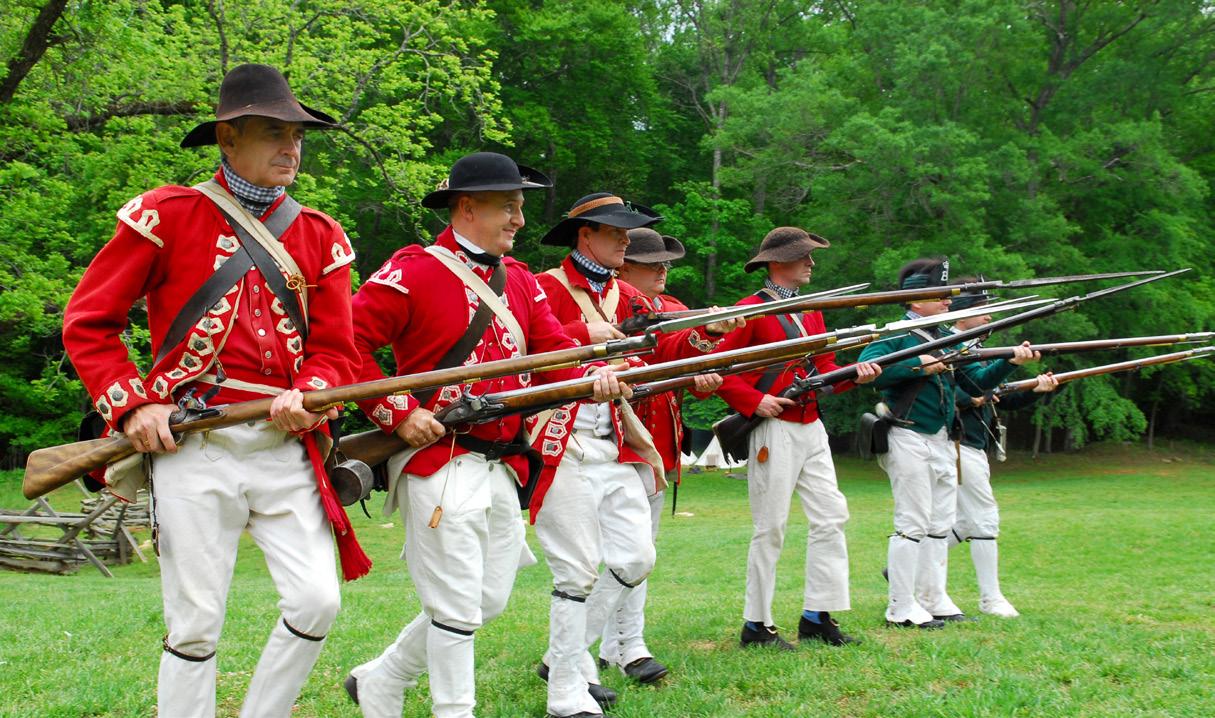

The Old 96 District of South Carolina, encompassing Abbeville, Edgefield, Greenwood, Laurens, and McCormick counties, is rich in history, culture, and outdoor adventures. Notable Revolutionary War battles, including the first Southern land battle and the Battle of Musgrove Mill, took place here. Today, visitors can explore the preserved forts and other historic sites while enjoying hiking, biking, and other outdoor activities in the scenic landscapes of the region.
The Ninety Six National Historic Site features forts from both the loyalist and patriot sides of the battle, connected by a 1-mile loop trail that provides historical context and insights into colonial life before the war. The Battle of Musgrove Mill State Historic Site also offers a wealth of information with unique dioramas that guide visitors through each stage of the battle, as well as hiking trails. Another engaging outdoor historical activity is the 10 Governors Trail in Edgefield, which includes informational plaques about the ten South Carolina governors from the county.
In addition to the notable Revolutionary War battles, the Dave the Potter story/ Edgefield pottery history offer fascinating insights into local craftsmanship and cultural heritage. The Benjamin E. Mays Museum stands as a significant landmark in Civil Rights history, honoring the legacy of an influential leader. Sharon Manor, an
old schoolhouse converted into a charming bed and breakfast, provides a unique lodging experience, while the Abbeville Opera House, a beautifully preserved historic theater, offers a glimpse into the region’s cultural past. At the Heritage Gold Mine, visitors can explore the second-largest gold vein in South Carolina and try their hand at panning for gold during select dates in the summer.
For a nostalgic and family-friendly experience, the 25 Drive-In remains a fully operational drive-in movie theater. The Greenwood Railroad Historical Center showcases the rich history of rail transportation in the area. Together, these sites provide a diverse array of attractions that celebrate the history, culture, and outdoor beauty of the Old 96 District.
VisitOld96SC.com
• Willington On The Way: In McCormick County’s historic area in Willington, SC, you’ll find the African American Culture Center, a museum, a country store replica, and extensive local genealogical information.

• The Cherokee Path: Located at The Ninety Six National Historic Site, this is an easy 1.5-mile trail once used by traders, trappers, Native Americans, and settlers to exchange goods between the backcountry and the coast.


Discover the rich history of Hardy County through Samuel Kercheval’s History of the Virginia Valley (1833). This historic perspective brings to life the stories of Hardy County’s lands, waters, and people. Join us on a journey through Hardy’s mountains, rivers, and valleys, guided by this fascinating text.
POTOMAC WATERSHED RIVERS
“...a little east of Thornbottom is situated a most beautiful miniature lake, called the Trout Pond.”
Though sometimes just a puddle, Trout Pond is West Virginia’s only natural lake and a highlight of the Trout Pond Recreation Area, renowned for its hiking and fishing. Fed by tributaries winding through the hills, the waters feed the South Fork which drifts into the South Branch of the Potomac River and the Lost River which disappears underground at the Lost River Sinks to emerge as the Cacapon River. Kercheval’s descriptions capture his delight in these Potomac Watershed rivers, celebrated for their excellent paddling and fishing adventures.
OUTDOOR INFLUENCES
While Kercheval’s writing reflects the lack of understanding of the indigenous culture, a culture that connects Hardy’s place names and heritage to a long-ago era of early Native American settlements, his anecdotal and factual information gives us a glimpse of “frontier” life beginning in the early 18th century. He writes of the Lee Sulphur Spring and Henry “Light Horse Harry” Lee’s ownership of the thousands of acres that became Hardy County’s premier recreational asset, Lost River State Park. On those same acres, close to the Cranny Crow Overlook, the c1840 Tusing Cabin hints at the hardship of early settlement on Big Ridge Mountain The park’s Legacy Cabins, primitive

Fire Tower cabin, pavilions and a trail system were built by the CCC in the 1930’s and the mountain bike trails, being constructed in the park’s north end, will add to the amenities nearly a century later.
In the early 18th century, European settlers moved into the valleys, often securing land through Virginia warrants or Lord Fairfax’s land grant. The Fairfax Line, surveyed by a young George Washington, defined part of Hardy County’s boundary. Washington later fought in the French and Indian War over much of this area. Kercheval
home to Hardy County where he built a log cabin in 1790. This cabin, now being restored as a museum, reflects his life’s story as it parallels the nation’s development.
Wardensville was the terminus for the Winchester and Wardensville Railroad completed in 1921. Later becoming the Winchester and Western, the railroad served until the late 1930’s as a commuter train and transported timber and agricultural products after it was linked to the narrow-gauge Lost River Railroad Connecting to the county’s agricultural heritage, Wardensville is the home of Farms Work Wonders, a nonprofit that works to “ignite the spark of curiosity within Appalachian youth” through leadership, on-thejob training, and empowerment. A small town with great character, its
structures include several historic homes and even a tiny jailhouse along the main street.
This barely touches Hardy’s history. Civil War sites and memorials, the 19th century Capon Charcoal Furnace, the Hardy County Barn Quilt Trail, the 250th anniversary of the Town of Moorefield’s founding, and the Historic Schoolhouse Trail all contribute to the County’s story.
VisitHardyWV.com
HISTORIC EVENTS
• Explore Hardy’s history and more throughout the year at the 38th Annual Wardensville Fall Festival, October 11th-13th, and at the upcoming 71st Annual Heritage Weekend, September 27th- 29th.

READY TO TEST YOUR LIMITS?
The Blue Ridge is full of rugged endurance races that will test the toughest mountain athletes, and we’ve rounded up some of the best. We’ve included mostly ultra-distance trail runs, with a few multi-sport events thrown in for good measure, and we’ve also listed a few great shorter distance options for those who want to ease in. Get your training plan in order and sign up for one of these races that will push your physical boundaries while you bask in
some of the best natural scenery the region has to offer.
Ultimate Distance
Rim To River 100
Ultramarathon
Fayetteville, West Virginia
Oct. 25-27
West Virginia’s first and only 100-mile trail race pits brave participants against a hellacious, out-and-back course that carries them deep into the heart of the 70,000-acre New River Gorge National Park & Preserve. The
These tough endurance races offer grueling challenges through some of the Blue Ridge’s most scenic terrain
BY ERIC J. WALLACE
route strings together gnarly singletrack with rail-to-trail connectors that seem to endlessly dip into the 1,600-foot gorge then climb back to surrounding peaks. A hit parade of natural beauty includes tons of bouldery creek crossings, more than a dozen waterfalls, famed whitewater sections on the New, 2,000-foot overlooks, and a jaunt through an abandoned historic mining town. Racers have 32 hours to complete the route, and those that do are awarded with serious bragging
rights, a custom belt buckle, and handmade finisher mug. rimtoriverendurance.com
West Virginia Trilogy
Three-day Ultramarathon
Circleville, West Virginia
Oct. 11-13
This epic three-day event in the Monongahela National Forest boasts a triptych of gorgeous trail runs through the high Alleghany Mountains of the 100,000-acre Spruce Knob-Seneca Rocks National Recreation Area, and it’s
not for the faint of heart. Day one brings a 50K gauntlet centered around iconic peaks and stunning rock formations at Seneca Rocks. Day two, a 50-miler with more than 8,300 feet of elevation gain through expansive woodlands, high-elevation red spruce forests surrounding the 4,800-foot summit of Spruce Knob, and a stretch on the 311mile Alleghany Trail. Day three wraps up with an out-and-back half-marathon past Spruce Lake to panoramic, 3,500foot views from the Gatewood Lookout Tower. wvmtr.org/races/wv-trilogy
Pilot Mountain to Hanging Rock Ultra Ultramarathon & Relay
Danbury, North Carolina
Sept. 28
Heralded as “one of the most challenging ultramarathons in the southeast,” the 50-miler connects two of North Carolina’s most celebrated state parks via paved country byways and trails on private property and other public lands. The course has a 14-hour time limit, begins at 3,872-acre Pilot Mountain State Park and pursues the Sauratown Mountain range through the tiny community of Pinnacle to end at 9,011-acre Hanging Rock State Park. It brings nearly 8,000 feet of elevation gain, dozens of creek crossings, a hundred-plus-stair climb to the finish, and soaring 2,500-plus-foot overlooks with views of the parks’ namesake rock formations. Racers looking for less distance should check out two more tiers of offerings, including a 50K run and a two-to-four-person 50-mile relay. pm2hrultras.com
Pisgah 555
55.5k Adventure MTB / Running Pisgah Forest, North Carolina
Oct. 5
Run or pedal 39.7 miles of some of the nation’s most coveted singletrack in North Carolina’s Pisgah National Forest. The race begins and ends across the street from the Davidson River Campground less than five miles from the hip mountain outpost of Brevard. It climbs a rugged 7,325 feet and includes a hit-list of gnarly Pisgah favorites like Black Mountain, Turkey Pen Gap, Laurel Mountain, and Pilot Rock. Cross-country MTB fanatics can up the ante with the event’s infamous sister race, the Pisgah 111, which offers a thigh-crushing 65.1mile pedal with 10,200 feet of climbing. pisgahproductions.com/events/pisgah55-5k-mtb-race
Triathlon Adventure Race
Chattanooga, Tennessee
Nov. 16
The unique three-part Pangorge adventure race was founded in 2014 and has since achieved legendary status among in-the-know racers. Participants explore some of the wildest areas in the 26-mile-long Tennessee River Gorge, abutting the vast 24,600-acre Prentice Cooper State Forest. Each gets a map of mandatory mountain biking, trail running, and paddling checkpoints before the race and devises a plan to complete them in whatever order and by whatever route they see fit. To make things more interesting, racers can KO bonus checkpoints of various difficulty levels to subtract minutes and seconds from their final time. The focus on navigational strategy means overall distances can vary dramatically, with 2022 podium takers ranging from 59.26 to 102.6 miles to finish. pangorge.com
50K, 30K, 15K Trail Runs
Blue Ridge, Georgia
Oct. 5
Push your limits among a kaleidoscope of fall foliage in the high Blue Ridge of northeast Georgia’s Chattahoochee National Forest. Start and finish just over the historic Shallow Ford Bridge in the cool little trail town of Blue Ridge. Take on highlights like 8,000 feet of elevation gain along a 23-mile stretch of the Benton MacKaye Trail, followed by seven miles of remote and densely wooded forest roads. The former offers many stream crossings, a beautiful double waterfall, spans of near-magical rhododendron thickets, and glorious 3,000-foot views of surrounding peaks and valleys. warriorraces.com/blueridgeultra
Galax, Virginia
Sept. 21
The crown jewel of the annual 24race Virginia State Parks Adventure Series, this legendary Galax-area event is held entirely within the linear, 57-milelong New River Trail State Park and is the Commonwealth’s longest-running adventure triathlon. Individual racers and teams have tested their mettle since 1999 on a 40-mile, out-and-back bike leg, 12.1-mile downriver paddle—

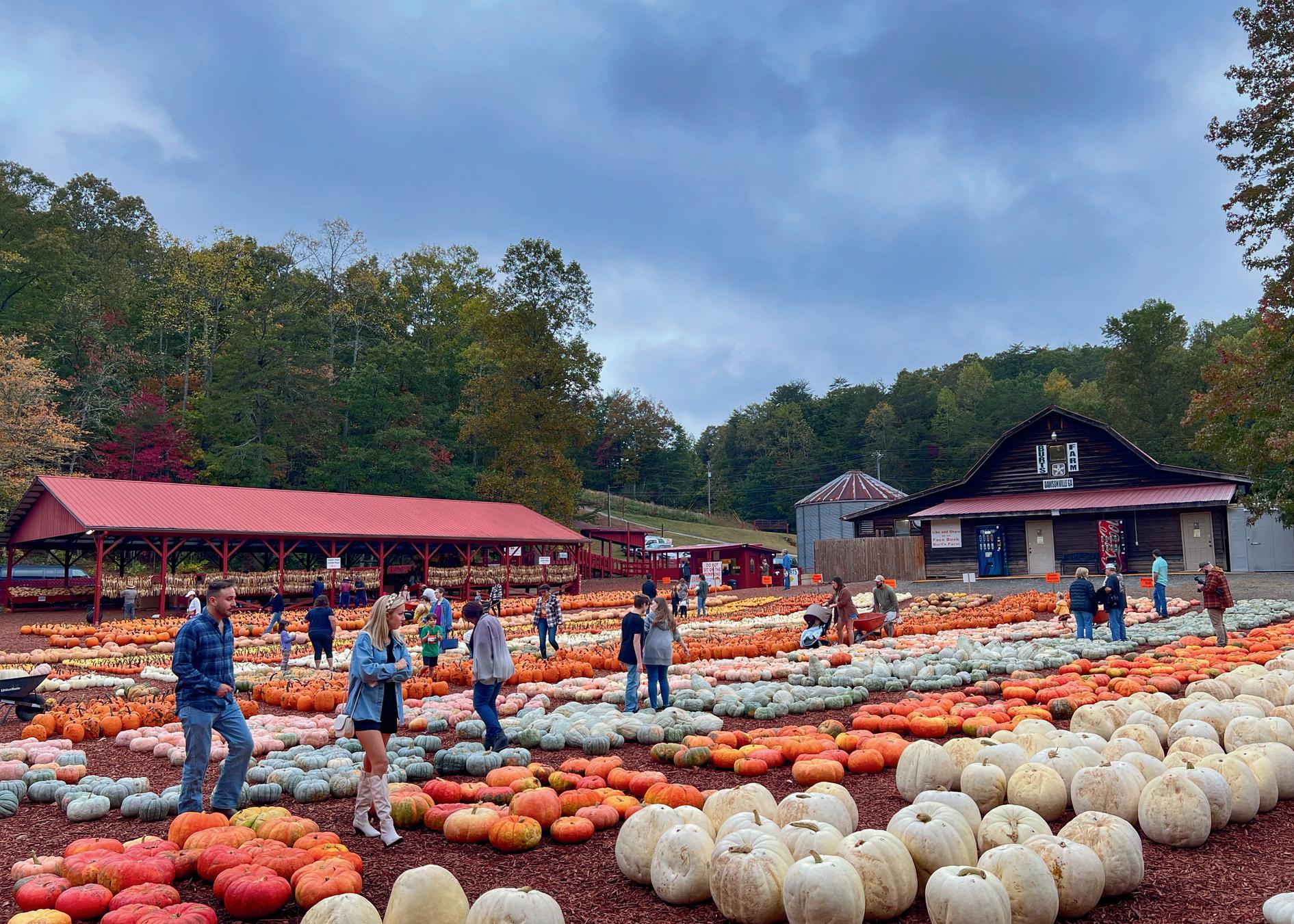



chock full of fun riffles and lowkey rapids—and final half-marathon dash along the New. Expect rural mountain scenery with race amenities like “backyard barbecue style meals” and brews from Creek Bottom Brewing Company. Participation is capped at 250 contestants, so be sure to register early. dcr.virginia.gov/stateparks/nrt-challenge
Not quite ready for mega miles? No worries. These three races are challenging but less overwhelming favorites that pack plenty of backcountry fun and adventure.
16-, 30-, 40-, and 50-mile Trail Runs
Damascus, Virginia
Aug. 31
Head to southwest Virginia and post up in the funky Appalachian Trail town of Damascus for an action-packed run in the woods that varies in intensity from over-the-top demanding to tough but doable. The route begins and ends downtown with a beautiful jaunt along and over Laurel Creek via the Virginia Creeper Trail. Next comes a miles-long ascent via winding singletrack along the spine of the Iron Mountain range that carries runners deep into the Jefferson National Forest. The route offers long rocky ridgelines, incredible oak forests and 4,500-foot scenic vistas with jaw-dropping views of the 115,00-acre Mount Rogers National Recreation Area. The 50-miler includes more than 8,000 feet of elevation gain. sites.google.com/site/ironmountaintrailrun
13.1-mile Trail Run
Slade, Kentucky
Oct. 5
The Rugged Red has been inviting runners to explore the stunning, 29,000-acre Red River Gorge Geological Area and

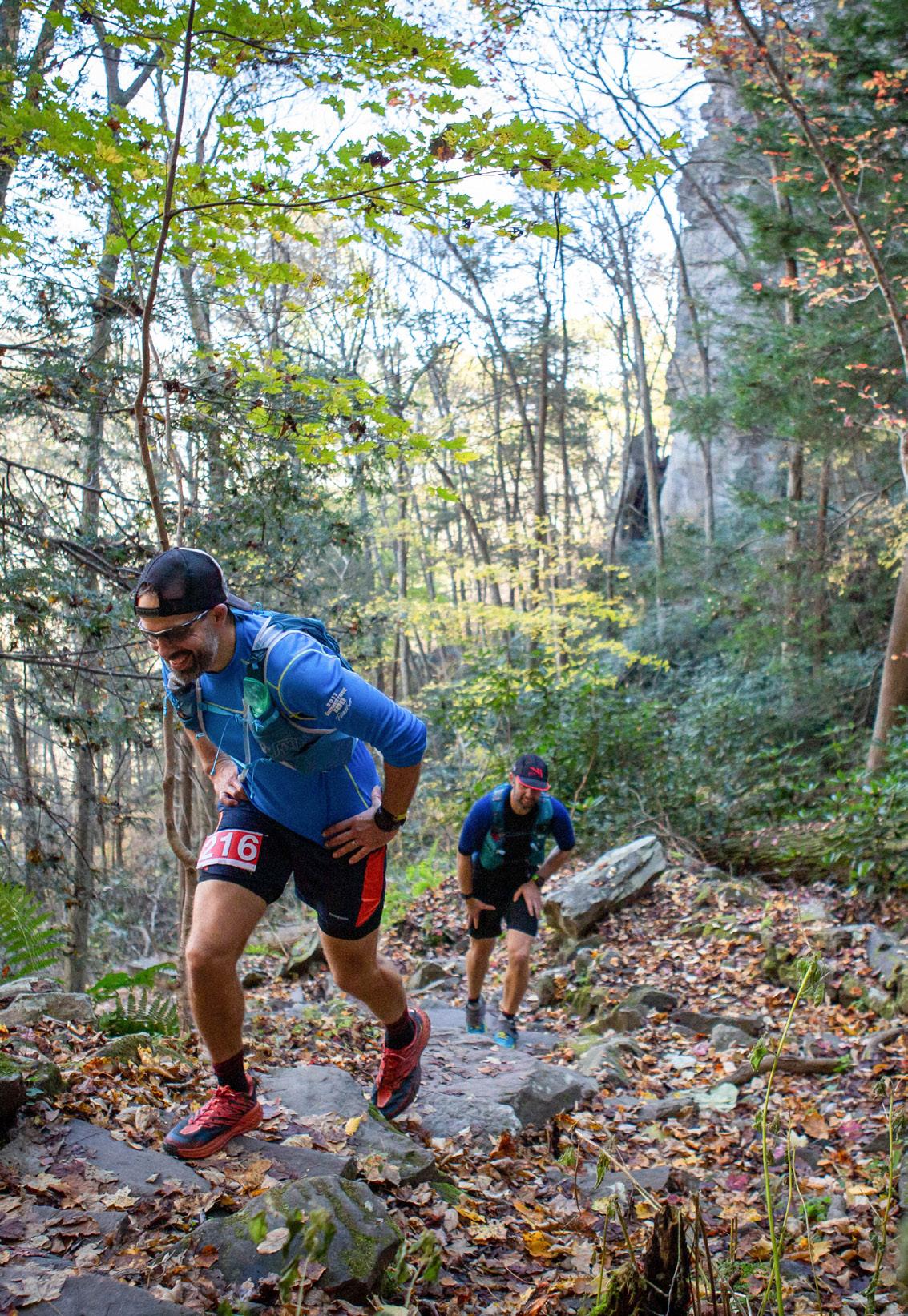
neighboring 2,250-acre Natural Bridge State Resort Park for going on 10 years. Camp or book a room in the lodge at the latter then enjoy a day of running in the Daniel Boone National Forest on one of the most demanding and scenic trail routes this side of the Mississippi. The 13.1-mile loop dips about 1,000 feet into the canyon system, crisscrosses the boulder strewn Red River, passes numerous waterfalls, and ascends to overlooks with views of the park’s famed sandstone cliffs and 150-plus natural stone arches. Shorterdistance runners can take advantage of the Rugged’s sister 5K. redrivergorgevacations.com/events/rugged-red-race-series
Half Marathon Trail and Road Races
Greenville, South Carolina
Oct. 12-13
This two-day event features optional, back-to-back half marathons held in and around South Carolina’s Paris Mountain State Park. Day one boasts a trail run with 2,500 feet of elevation gain that’s designed to highlight some of the state’s most spectacular mountain scenery. It passes through lush forests alongside rushing creeks and tranquil, 13-acre Lake Placid, then climbs a gauntlet of steep switchbacks to panoramic eye candy, including the nearby city of Greenville, from a stone viewing platform atop the park’s namesake 2,500-foot peak. Day two switches gears with a road race with 2,000 feet of elevation gain along scenic byways lined with overlooks of the park and surrounding valleys. runsignup.com/Race/SC/Greenville/ ParisMountain



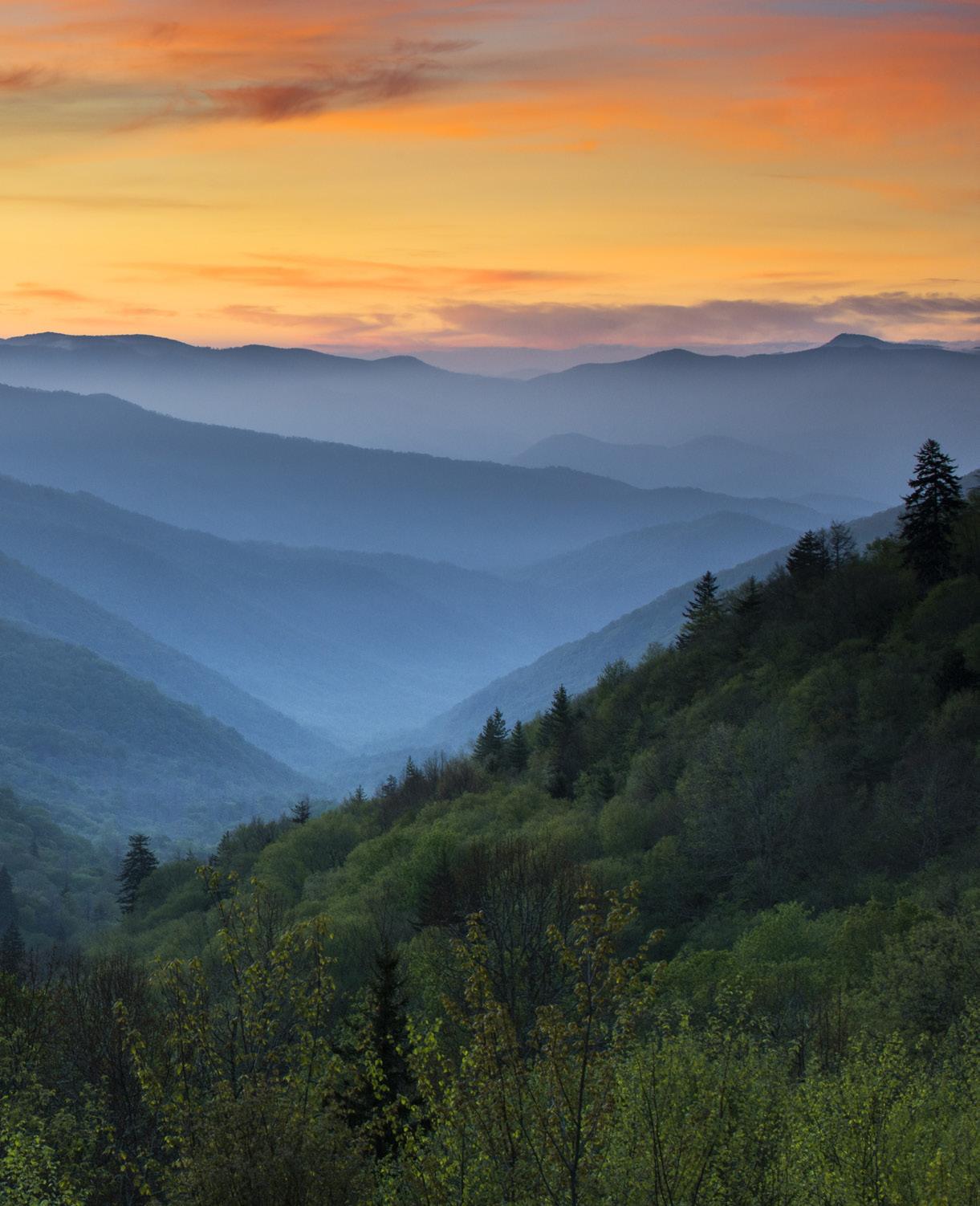
BY WILL HARLAN

ON A SUNNY SATURDAY MORNING, my 10-year-old was sprawled on the couch zombied to his device. I felt a wave of shame wash over me: I had failed as a parent. In disgust and resignation, I slumped down on the couch with him. Then a TikTok video flashed through his feed showing a weary triathlete stumbling across the finish line.
“Do you want to do one of those?” I asked him.
“Sure,” he said.
Before he could change his mind, I registered him—and our entire family—for a triathlon.
We were complete newbs. My kids had never ridden a road bike, and the only swimming they’d done was at the pool. We had a lot to learn, and the learning curve—and price tag—were steep.
Lesson one: Triathlons can be expensive: the equipment for three sports adds up quickly. This would be a low-budget triathlon for us. I bought used road bikes from Craigslist and repaired them myself.
My wife wasn’t sure that a family triathlon was a good idea. “Our kids better not end up getting killed,” she warned me.
She had reason for concern. My kids didn’t exactly train. They did a couple of short bike rides and called it good. On those rides, Finn kept veering all over the road as cars zoomed past. I did my best to box him in.
We signed up for a triathlon at

Anna State Park in central Virginia. My wife Emily and our teenage son River would tackle the Olympic distance triathlon (1-mile swim, 25-mile bike, and 10K run), while my younger son Finn and I would try to complete the sprint triathlon (1/4-mile swim, 15-mile bike, 5K run).
On race morning, things did not get off to a good start. We were already late because I had to take my morning shit. Now, my younger son Finn had to poop too. So we stopped at a gas station, where we noticed that one of the bikes had a flat tire. We quickly scrambled to fix it.
We rolled up to the triathlon looking like the cheap amateurs we were. All of the other vehicles in the parking lot had fancy racks and equipment lockers adorned with stickers from previous triathlons. We arrived pulling a farm trailer stacked with used bikes and an old duffel bag crammed with gear. We hustled down to the lake, where the swim was about to start.
The sprint triathlon began first. Finn and I dashed out into the cold lake with about 100 other swimmers. Finn had not trained at all for the swim, and my wife was especially nervous about him being in the open water. “You have one job today: make sure Finn doesn’t die,” she reminded me.
The frigid water sent a shock of adrenaline through Finn. He thrashed

in something resembling freestyle. I swam next to him and encouraged him to find a comfortable, steady pace. Then his goggles fogged up and he began meandering way off course, so I swam on his outside and boxed him in. Every few minutes, we took a break to swim backstroke and catch our breath. When we rounded the final buoy, Finn unleashed a vicious kick.
“Fuck this water!” my 10-year-old shouted, slapping harder with each stroke.
We crawled ashore, alive, and not in last place.
Meanwhile, Emily and River were just starting their swim. Emily had trained more than all of us: she had bought a membership at a local pool and reserved swimming lanes three days a week, where she glided through her workouts.
But open water swimming was a different beast. The crowds, choppy waves, and cold water sent her into a panic. She couldn’t catch her breath, which made the panic worse. She collided with a nearby swimmer and was kicked underwater by another. She thought about dropping out and spotted a rescue boat nearby. Then somehow, amid the flailing arms and legs of other swimmers around her, she was able to calm her breathing and find her stroke.
Finn and I started our ride. On the bikes, I rode closest to the cars and kept Finn contained near the
shoulder of the road. The hardest part of the ride was battling the boredom. I tried to distract Finn from the monotony by asking him questions about his favorite soccer players. He asked me questions, too—mostly versions of “Are we there yet?”
But Finn had a lot more left in his tank. After the bike ride, Finn flew through the 5K, passing dozens of runners. He scorched across the finish line, winning the youth age group. Moments after finishing, he wanted to go back out to cheer on his mom and brother.
They had just finished the bike and were starting their run. Like Finn, they blazed through their miles. The swim and bike portions had given other triathletes a head start, but River and Emily closed the gap on the run. They both finished near the top of their age groups and way ahead of their personal goals.
Earlier that morning, repairing bikes and taking massive shits moments before the race, I didn’t think there was any way that all four of us would finish. Certainly, a bike malfunction or another flat tire or an unexpected cramp or injury would take down a few of us. Somehow, our entire rookie crew made it across the finish line.
On the drive home, the boys were already back on their screens, but Finn looked up for a moment and said, “Let’s do one of those again.”
The top outdoor races, festivals, events and experiences in the Blue Ridge and Beyond. Check out some of our top picks here and online at blueridgeoutdoors.com

Meet the Mountains Festival
August 9 - 10
Johnson City, Tenn.
The award-winning Meet the Mountains Festival is a one-stop shop to immerse yourself in Johnson City's world-class outdoor assets and encourage stewardship of its natural landscape.
MTMFEST.ORG
Midnight Flight
August 16
Anderson, S.C.
Midnight Flight has been a tradition in the Anderson Community for 46 years. Over 1,000 runners participated last year. The road-race is a certified Grand-Prix race and the largest night-time race in South Carolina. The 1 mile will begin at 8:15 p.m., and the 5K at 9 p.m.
ANDERSONAREAYMCA.ORG
73rd Annual Georgia Mountain Fair
August 16 - 24
Towns County, Ga.
Look forward to TWO GREAT WEEKENDS at the Georgia Mountain Fair, held in Hiawassee, Ga! Enjoy first-class music performances, arts & crafts, fun carnival rides, and a glimpse into North Georgia’s rich history and culture! Parking is FREE and children 12 and under are FREE!
GEORGIAMOUNTAINFAIRGROUNDS.COM
Ashland Half Marathon & 5k
August 24
Ashland, Va.
If you’ve never been to Ashland, Virginia look no further than the Ashland Half Marathon to find yourself soaking in every ounce of the colorful town! Escape to small-town Virginia and run 13.1 miles along rolling hills, picturesque fields, and maybe even a train or two. Now with a 5k!
SPORTSBACKERS.ORG
Front Porch Fest 15
August 29 - September 1
Stuart, Va
This intimate gathering on the front porch to the Blue Ridge Mountains is perfect for families of all ages, seasoned festival goers, and first timers. A true grassroots event, Front Porch Fest is a premier Patrick County destination. Tickets available now.
FRONTPORCHFEST.COM
Chartway Virginia Beach 10 Miler & 5K
August 31 - September 1
Virginia Beach, Va.
Celebrate the end of summer the Virginia Beach way with a classic Labor Day Beach Party. The weekend offers a Kids 1 Miler, 5K, 10 Miler, and “Live the Life Challenge” along with a J&A Racing infamous beach party featuring cold beer and live music.
VB10MILER.COM`
Beaver Dam Sunflower Festival
September 6 - 15
Buchanan, Va.
The Beaver Dam Farm Sunflower Festival takes place in Buchanan, VA and is the largest Sunflower Festival on the East Coast. Celebrating its 10th anniversary this year, the festival features over 600,000 sunflowers in bloom and a variety of fun, family-friendly activities.
BEAVERDAMSUNFLOWERS.COM

September 19 - 21
Martinsville, Va.
The Infamous Weekend Festival includes three days of music on two stages, river floats, fly fishing, disc golf, a bike ride and other outdoor adventures. The festival is presented by Rooster Walk & The Infamous Stringdusters. On-site tent camping included. Kids 12 and younger are free.
INFAMOUSWEEKEND.COM
World Chicken Festival
September 26 - 29
Downtown London, Kentucky
Free entertainment on two stages, thrilling amusement rides, outrageous contests, quality craft & food vendors and the World’s Largest Skillet that fries up delicious fried chicken! Check this off your bucket list and join us for a fun and fabulous festival!
CHICKENFESTIVAL.COM
September 28
Lynchburg, Va.
This year, the historic Moore & Giles Virginia 10 Miler will celebrate its 50th year of running in LYH. Join more than 3,000 runners on a historic course that hosts participants from around the globe for a 10 mile run, 4+ mile run/walk, or an Amazing Mile Children’s Run.
VIRGINIA10MILER.COM
2024
Crawlin' Crab Half
Marathon presented by Bon Secours
October 5 - 6
Hamton, Va.
Complete with a snappy fast and flat course on the water, ample room for friends and family to cheer you on and a pumped up and picturesque post race celebration! The Crawlin’ Crab Half Marathon Weekend is the perfect place to run, crawl, and SHELLebrate.
CRAWLINCRABHALF.COM

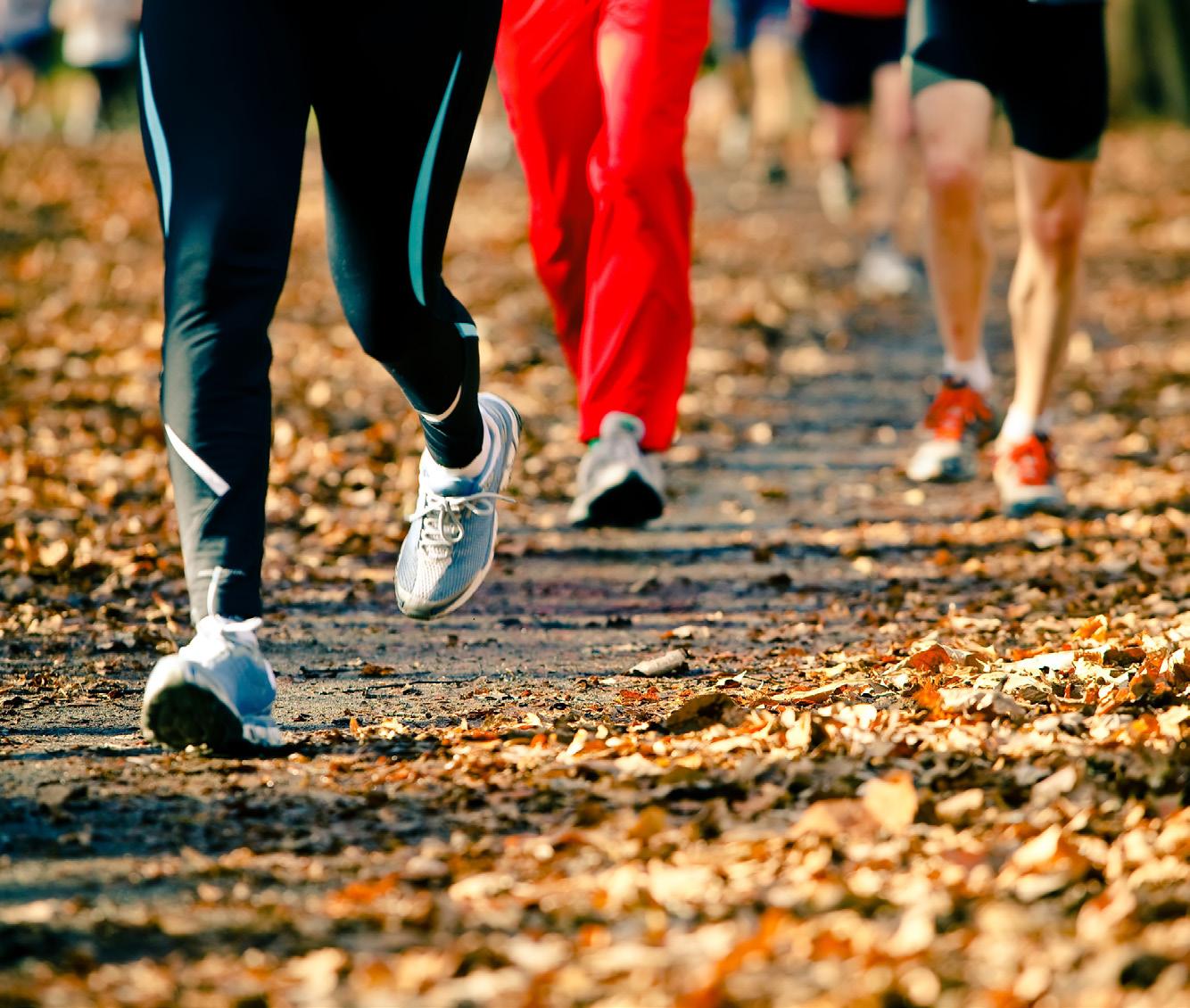
LEAF Global Arts Festival
October 17 - 20
Black Mountain, N.C.
LEAF Global Arts Festival is a family-friendly event celebrating global arts and cultures through live music, dance, visual and performing arts, and so much more. Enjoy camp and lake activities at beautiful, historic Lake Eden.
THELEAF.ORG
NC Liver Mush FestivalMush, Music & Mutts
October 19
Uptown Shelby, N.C.
Enjoy live music, kids zone, RollOver Pet Zone, 100+ vendors and, of course, Liver Mush!! With an estimated 2023 attendance of over 10,000 and growing, we are proud to bring the festival back better than ever in 2024! Free to attend, pets welcome, and fun for the whole family!
NCLIVERMUSHFESTIVAL.COM
Old Point National Bank Wicked 10K
October 26
Virginia Beach, Va
Come experience Coastal Virginia’s largest Halloween race and party. Do you love Halloween? Do you love the ocean? Looking for a few tricks and treats? The Old Point National Bank Wicked 10K Weekend is the perfect place to
celebrate Halloween and enjoy wicked good times.
WICKED10K.COM
November 2024
Allianz Partners Richmond Marathon November 16 Richmond, Va
Whether you take part in the Allianz Partners Richmond Marathon, CarMax Richmond Half Marathon, or VCU Health Richmond 8k, Richmond provides phenomenal course support, great fall scenery, and awesome finisher swag. Don't miss the 47th running of America's Friendliest Marathon! Beat the 9/16 price hike!

RICHMONDMARATHON.ORG
Wilderness First Aid 20hour certification course November 16 - 17 (and more) Charlottesville, Va. (more below)
Learn vital safety skills for outdoor adventures and travel. More dates and courses in DC, Baltimore, Richmond, Blacksburg, Raleigh, Harrisonburg, Farmville, Philadelphia, Wilmington (DE) and more. Also hybrid and online learning certification options anytime, anywhere.
Registration and more dates/ locations: WWW.SOLOWFA.COM
Friday, August 16, 2024
Anderson Area YMCA I Anderson, South Carolina I mile at 8: 15 pm 5K at 9:00 pm


RW Shucks Seafood Block Party
November 16
Martinsville, Va.
Hosted by Rooster Walk, the R.W. Shucks Seafood Block Party combines fresh, delicious seafood truck vendors, live music, beer, wine and spirits in a historic downtown street party setting in Martinsville, VA. It’s a party… shuck yea! ROOSTERWALK.COM
December 2024
America Outdoors Conference and Outfitter Expo
December 10 - 13 Chattanooga, Tenn.



After an accident left her husband disabled, a woman came to the Blue Ridge to find accessible places for them to explore the outdoors.
BY CINDY ROSS

WHEN YOU FIRST ENTER THE huge black tunnel in the side of the mountain, you cannot see the other side, where it once again enters the light of day, about three quarters of a mile away. You can hear running water, which is a little disconcerting at first, but the crushed gravel trail looks promising. The gaping elliptical hole we enter is called the Claudius Crozet Blue Ridge Tunnel. It’s 4,273 feet in length and in the mid-1800s when it was constructed, it was the longest train tunnel in North America.
I’m about to push my husband in his manual wheelchair into its darkness. At 2.3 miles long, the Tunnel Trail is located below Rockfish Gap near Waynesboro and Afton, Va. At first this didn’t seem like the typical destination for the disabled, but we found the trailbed easy to navigate.
A few years ago, my very athletic and adventurous husband Todd suffered a devastating fall, which broke his neck and resulted in an incomplete spinal cord injury. Since then, we decided we wouldn’t be content with a life indoors, away from the beauty of nature, with its calming peace and many health benefits. So recently
we traveled from our Pennsylvania home to Virginia’s stretch of the Blue Ridge to see what the area has to offer in the way of accessible trails.
We were thrilled to find multiple trails that make exploring the natural world possible for slow walkers and wheelers. Getting Todd to a trailhead isn’t always easy, but it’s worth it when I see the way being outside elevates his mood. Minor challenges like ruts or roots, or puddles of water makes things difficult, but overall, with a little energy, there are many trails we can navigate just fine.
We access the tunnel trail from the east entrance, (215 Afton Depot Lane in Afton), as it is a fairly flat .5-mile approach trail as opposed to a very steep hill on the west side. Inside, the damp coolness is comforting on a hot summer day, while the looming rock walls and the darkness help us imagine what it was like for the Irish immigrants to blast this massive tunnel. Then the welcoming light of day greets us on the other side.
We soon hear laughter echoing out of the tunnel and are surprised to encounter a jubilant group of young people, gathered around a
Shenandoah National Park. It’s a state-of-the-art accessible trail with very gentle grades and a smooth, finely crushed stone trailbed. The trail is wide enough for side-by-side walking, with benches sprinkled throughout for convenient resting, and diversity in the landscape as it winds through thick groves of mountain laurel, tall oaks, fascinating rock formations, and lacy ferns. Here we did a combo of my husband walking with his walker, then riding in his manual chair when he grew fatigued. This trail has some grades, although gentle.
- From the Luray-Hawksbill Greenway in Luray spot bucolic cows munching away inside the fence that the trail circles around. This entirely black-topped trail is a cinch to navigate across with an accessible bathroom part way round the .8-mile loop trail (Trail is a Lollipop configuration).
girl with cerebral palsy in a power chair. Kaili Webster is with her church group, having a fun day outdoors. Stephanie, her mother, says the kids chose this trail because they know it is accessible and how much it means to Kaili to join in activities on fellowship outings. “It means so much to her to be a part of the group and feel no different than anyone else.”
Later, we overnight in the historic Big Meadows Lodge in the central section of Shenandoah National Park. It offers very comfortable accessible accommodations, with our room’s own private entrance. Todd’s wheelchair can get through the door, fit under the sink, and get into the shower. There is so much charm at this rustic mountaintop lodge, with far-reaching vistas from the lodge deck, and its restaurant serves delicious food, offering some Southern favorites, like fried green tomatoes, Virginia peanut soup, and hush puppies made with Virginia sweet corn, served with local hot honey. After a night of rest, we spent the rest of our trip finding more accessible trails in the area.
- Another favorite is the 1.3-mile circuit Limberlost Trail in the
- The .8-mile Augusta Springs Wetland Trail in George Washington National Forest outside Augusta is a sweet circuit trail. It’s an aging trail that could use some repairs, but the boardwalk across the swampy marshland is particularly scenic and home to multiple waterfowl. It took us a little more effort than usual to push across some spots, as it goes from boardwalk to dirt trail, but it’s worth a visit, with white pine forest that is lovely in the summer and a great accessible bathroom.
- The .5-mile interpretive Massanutten Storybook Trail outside New Market is a fabulous paved accessible trail, leading to a spectacular view of the Shenandoah Valley and Blue Ridge Mountains but unfortunately some of the boardwalk burned in the spring 2024 Shenandoah fire and is temporarily closed, awaiting repair.
Many other accessible trails can be found by searching wheelchair and stroller-friendly trails at AllTrails. com and TrailLink.com of the Rails-to-Trails Conservancy. The National Park Service also offers a free lifetime Interagency Access pass to permanently disabled folks. You can obtain your pass at the park entrance station, or online at nps.gov/subjects/accessibility/ interagency-access-pass.htm.
BY GRAHAM AVERILL
IT WAS A SERIES OF QUESTIONABLE decisions that led me to this point, staring at a fork in the road, wondering which direction to go. I sit on my bike, look at my map, and wonder why the trail I had just ridden is nowhere to be found on the piece of paper. I know the trail was real. I rode it. It was hard. I had to get off my bike and push several times. The pain is still lingering in my legs, but there’s no black or blue line on the map representing that pain visually, so I have no idea which direction I should pedal on this road. I’m already late. The sun is starting to set. I was supposed to be back at camp an hour ago, and if I choose the wrong direction, I’ll be pushing my bike back to the tent in the dark.
It’s hard to pinpoint the exact moment when a situation turns south. I like to think it’s a collection of poor decisions that potentially culminate with me finding my way through the woods like a blind man reading braille. Pedaling up a trail with no marker, not putting a headlamp in my backpack, choosing to knock out a “quick loop” before dinner with no solid understanding of the local trail system…all of these decisions have helped inform my predicament, but ultimately, I’m in this pickle because I decided to veer off my normal course of action. This is what I get for trying something new.
I’m a sucker for consistency. I thrive in routine. Same cup of coffee each day while watching the same sports news show at the same time every morning. Same lunch-break workout. Same tacos on Tuesday. I run the same 3.5-mile loop three times a week and bike the same road/gravel route around town twice a week. I walk the dog around the block in the same direction, say hey to the same neighbors. It’s ironic, considering I make a portion of my living by writing about traveling to new places, but the truth is, I’m at

my best when I’m planted firmly in the center of my comfort zone.
But here I am, in the middle of a spur-of-the-moment, one-night camping trip in a section of Pisgah that I rarely set foot in, because my daughter asked me to take her camping with a couple of her friends. Sure, the dads were only invited on this trip to drive the vehicle, set up the tents, and cook the meals—we're like unpaid Sherpas—and the girls probably would’ve gone on their own if we’d allow them to hitchhike and just eat Twizzlers for dinner, but I’m not going to let the truth get in the way of how I’ll remember this situation when I’m on my deathbed. In my revisionist history brain, I’ll recount this tale as the time my teenage daughter asked me to go camping with her.
So I didn’t give it a second thought when she said the plan from the other dads was to camp on a creek in a section of the forest I had never explored before. I couldn’t pack the truck fast enough. Visions of quality father/daughter time danced through my head. We would tell ghost stories around a campfire. We would name constellations in the sky. I would show her how to fish with a spear. Never mind the fact that I don’t know how to interpret the night sky or spear a fish…I would wing it.
Instead, I’m in the middle of the woods, pedaling what is sure to be the wrong way up a gravel road, and it’s all because we veered from the ordinary and I got lost.
Everything about this trip is
different. Instead of lugging the whole family camping, it’s just the two of us. I let my daughter pick the menu for dinner, so instead of the pan-fried pizzas I normally make, we’ll have chicken teriyaki bowls with fresh fruit, if I ever get back to camp to make it. Fresh fruit while camping! Have you ever heard of such a thing?! The trails are strange. They’re extra bumpy, like trail crews added additional roots and rocks. And as I’ve stated, they’re not always on the map. Even the flora and fauna are different in this part of the forest. The ferns are bigger, like something out of Jurassic Park, and the squirrels are weird. Some of them are white. Local legend has it that a pair of albino squirrels escaped from a carnival truck decades ago and bred like bunnies in the woods.
Stupid white squirrels. Stupid trail that doesn’t exist on the map. I guess it’s my fault for putting the mountain bike on the back of my truck so I could do “a quick spin” before dinner. There are no quick spins in Pisgah. A mile-long trail could take you half a day if you’re ill equipped or unprepared. I am often both of those things.
At any point during my bike ride, I could’ve just turned around and retraced my steps back to the campsite and the beginning of that fictional trail, assuming I don’t break through the space/time continuum by doing so. This quick spin has turned into an epic journey because I’m an idiot and I probably have several miles to pedal before
I get back to the campsite to cook my daughter dinner. I hope I’m not missing any ghost stories.
Just as I’m feeling incredibly sorry for myself, the gravel slog transforms into a flow downhill on a trail that cuts a narrow path through the dense forest. After all the bad decisions, all of the white squirrels and fictional trails, I have a solid three or four miles of heart-pounding downhill with drops and fast turns that sneak up on me when I open up the throttle a bit too much. The trail traces the edge of a creek, which gets bigger as I continue down the slope, until I realize this is the same creek that runs beside our campsite. This beautiful, downhill path is taking me directly to my daughter, and I make it back to the campsite before dark and see that she’s been busy doing laps with her friends on a small sliding rock a few hundred yards upstream from our tent. She hasn’t even noticed I was gone.
We’ll have her rice bowls that night, and I’ll marvel at how wonderful fresh fruit tastes in the middle of the woods. I won’t be able to point out the stars to her because that’s not a skill I possess, but I’ll retrace my bike ride from earlier in the day, drawing in the fictional trail on the map, and highlighting the direction I took on the gravel road and putting a star next to the flowy downhill that brought me back to the start. I want to do that ride again. I want to add it to my routine and bring it into my comfort zone. This is what I get for trying new things.
september 19-21 , 2024
three nights of music & camping with
Daniel Donato's Cosmic Country • The Lil Smokies
The Last Revel • Dangermuffin
Jon Stickley Trio • Falco & Book play Garcia
The Wilson Springs Hotel • Isaac Hadden
Florencia & The Feeling • TC Carter Band
The Fly Birds at pop’s farm in martinsville, va
2 s tages • outdoor adventures fo od • ca mpin g • family fun
Hit the trails in the latest shoes and accessories to help keep you comfortable and confident while you rack up miles in the wild, whether you are training, racing, or just having fun.
BY DOUG SCHNITZSPAHN
Golden Gate 2 ATR


Built for comfort, this do it all shoe is the choice for those runners who spend time on both pavement and dirt. The forefoot and traditional, supportive heel work in tandem to keep your foot secure and rolling into each stride. Meanwhile, the dual-density EVA Bounce Foam takes the shock out of pounding the blacktop and negotiating rocky trails. And it weighs in at a mere 10.2 ounces in a men’s Euro size 42. $169; scarpa.com
Jackal II BOA
Light, at 10.5 ounces, and agile, this is the shoe of choice for those with ultra objectives. The double BOA lacing system may not be for everyone—but we wonder why not? Instead of dealing with lacing and double lacing and replacing, just dial in the fit and adjust on the fly if necessary. That perfect fit gives you better stability, while the Infinitoo cushion technology serves up a spring in every step alongside an outsole that can chew up rocks and roots. $111; lasportivausa.com
Sylan GTX
Looking for a shoe to give you some extra bounce and roll as you stride into the wild? This comfy 11-ounce trail runner’s big rockered midsole pumps you through each step, and the shoe’s ample space in the toe is a relief for finicky feet. The Vibram Megagrip outsole tackles a wide range of terrain and the Gore Invisible Fit liner keeps out the wet stuff. It may be too much shoe for some but the ideal fit for those who want a lot of oomph from their kicks. We like it as a day hiker, too. $230; arcteryx.com



Speedgoat 6

The latest greatest version of Hoka’s ever popular Speedgoat can climb, race, and ramble down the ugliest trails out there—and it will imbue you with the confidence to push your limits on race day. Credit that stability to the aggressive 5-mm lug pattern and ultralight CMEVA cushioning in the midsole that sucks up the abuse of gnarly terrain. Weighing 9.8 ounces in a men’s size 10, this shoe is so comfy and in control on the trail, some of us used it as a quiver of one for hikes, training, and racing. $155; hoka.com
Olympus 6
The latest iteration of Altra’s Olympus serves up plenty of comfort for those runs that rack up the miles—but it’s not too bulky for race days. Weighing in at 12.2 ounces for men and 10.2 for women, the shoe features a soft, breathable mesh upper and outstanding traction, thanks to a new big pattern on the Vibram Megagrip outsole that eats up both dirt and wet rock. As usual, Altra is a good fit for those with wide toe boxes. $175; altrarunning.com
Dauwaltermelon
Packing a punch of electrolytes and calories, this tasty energy drink will keep you powering though runs that would otherwise beat you down. Don’t believe us? Tailwind whipped up the mix


with Courtney Dauwalter, the first person to win Western States 100, Hardrock 100, and UTMB in the same year (and she won Hardrock again last month). $2.49 single serving, $40 box of 50; tailwindnutrition.com
Mountaineering brand Rab put all the know-how it’s gleaned from alpine endeavors into this light (just under 13 ounces) well-fitting running vest that’s mandatory for those big mile days. The ample pockets hold water and snacks and the ripstop material sheds moisture—but the real sell here is the fit system, which keeps the pack out of your way and tight to the torso without rubbing when you sashay down the trail. $180; rab.equipment
Dart Lite T Shir t
Trail running does not require a lot of gear, which is why the basics need to be perfect. This lightweight base layer made from recycled polyester answers the call for the demands of a run, wicking away moisture and sweat, while providing warmth when you need it for your core but staying cool when temps soar. $60; us.montane.com











Best New Music from the Blue Ridge and Beyond
BY JEDD FERRIS AND DAVE STALLARD
curate a playlist of new music, mainly focusing on independent artists from the South. In August we’re highlighting new tunes from Widespread Panic, Steep Canyon Rangers, and MJ Lenderman.
“Tackle Box Hero”
Georgia jam stalwarts Widespread Panic dropped a surprise new album, “Snake Oil King,” back in June, and although the group’s first studio LP in nine years comes in at a lean six tracks, it has some potent grooves that will please the band’s loyal fanbase. “Tackle Box Hero” is a seven-minute tale of an itinerant journeyman who skips town for smoother waters when trouble strikes. The tune is led by Panic keyboardist Jo Jo Hermann— a Professor Longhair disciple—who laces the lyrics with Gulf Coast imagery, as the titular character wants to “test the waters on a bayou day.” – J.F.
“Morning Shift”
North Carolina’s Steep Canyon Rangers have experienced a purposeful sonic evolution over their two decades of making music; the electric guitar lead and driving percussion in “Morning Shift” are a far cry from the band’s bluegrass chops showcased in their earliest albums. Still evident in this cut from their new live record, though, are the band’s grassy roots, with fiddle and mandolin runs cutting through a funky rock break that sees the band equally channeling Bill Monroe and the Allman Brothers . – D.S.
“Knee Deep Blues”
North Carolina songwriter Caleb Caudle is hounded by a litany of bad tidings in “Knee Deep Blues.” Over a staccato guitar and droning dobro, Caudle sings of all manners of evil omens, from crows to copperheads to shallow graves, painting the portrait of a character drowning in darkness. Framed between these anguished verses is the simple chorus of “I don’t want to think like that,” a resounding cry for help that reaches up from the murky shadows of an anxiety so many are familiar with. – D.S
“She’s Leaving You” Asheville’s MJ Lenderman stays busy playing in the band Wednesday, but he also makes time for solo output that mingles Neil Young’s distorted ragged glory, Uncle Tupelo’s foundational alt-country, and Pavement’s 90s slacker vibe. Next month Lenderman will release the new album “Manning Fireworks,” his debut for the well-respected ANTIlabel, and this preview single is a jangly rocking earworm about a character going through a midlife crisis. The theme is downcast, but the hook is super sweet, and it’ll rattle around your head for days.
– J.F
“Married for Love”
Mac McCaughan, co-founder of North Carolina-based Merge Records, had a hunch that two artists on his venerable indie label, Eric D. Johnson of Fruit Bats and Mackenzie Scott of Torres, would make beautiful music together. And when the two artists decided to give it a shot upon recommendation, McCaughan was proven correct.
“Married for Love,” a first look at a collaborative EP called “A Decoration” that’s out this month, is an airy meditation on romantic partnership that features gentle piano fills, delicate digital beats, and uber-sweet harmonies. – J.F.

“I Ain’t Ever Satisfied”
Steve Earle gradually lost his longtime band, the Dukes. In 2019, his steadfast bass player Kelley Looney sadly passed away and a few years later supporting players Chris Masterson and Eleanor Whitmore decided to leave the group. So Earle decided to go old school and perform as a folk singer, like he did in his early days when he was learning to craft a tune from the likes of Guy Clark and Townes Van Zandt. The result is “Alone Again (Live),” a new record compiled from performances on Earle’s 2023 tour that came out last month. A must-hear from the set is this raw, harmonica-heavy version of “I Ain’t Ever Satisfied,” a song the country-rock bard first recorded on the 1987 album “Exit 0.”
J.F.
“Dreams”
In 2020, Steve’s son Justin Townes Earle tragically died of an accidental overdose at the age of 38. Although inexorably linked to his father, the younger Earle carved out his own
To
these
and
niche in the songwriting world, becoming one of his generation’s leading voices. This month, New West is releasing “All In: Unreleased & Rarities (The New West Years),” a collection of demos and previously unheard recordings that includes Earle’s take on Fleetwood Mac’s “Dreams.” Another opportunity to take in Earle’s sonorous Southern drawl won’t be lost on fans who recognize the void his passing has left. – D.S.
Washington, D.C., soul combo Oh He Dead brilliantly mix lush, 80s-era synths with fuzzed out guitar and frontwoman CJ Johnson’s powerful vocals on “Strange Love,” the first single from their new album, “Ugly.” The song’s ebullient opening belies its inspiration; Johnson is singing from the perspective of a sex worker who has fallen in love with one of her clients. Romantically tragic, the band crescendos to a desperate finish, taking a heavy sonic turn to depict the fraught and unrequited love of Johnson’s subject. – D.S.
